Accounting Top
Accrual Based Accounting Top
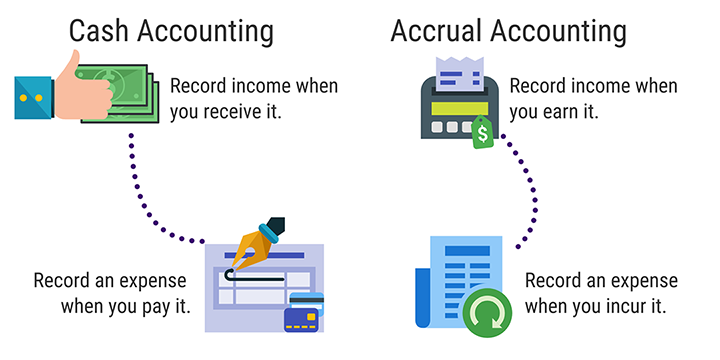

Accrual accounting is a financial accounting method that allows a company to record revenues or expenses before receiving payment or paying for goods and services.
Accrual Based Accounting reflects the understanding that the economic effect of a revenue generally occurs when the event occurs (e.g. tickets bought), not when cash is received. This approach supports deferred accounting, management of receivables, post dated payments and other features. In the US, the IRS requires accrual accounting for 'C' organizations, and the Canada Revenue Agency has similar rules.
Theatre Manager is designed exclusively around Accrual Accounting principles.
Deferred Revenue Top
Deferred revenue results when payment for goods and services (e.g. tickets to an event) is received in advance of the goods being delivered (e.g. the performance date). In accrual accounting, deferred revenue is a liability (the goods or services are still owed) until the event has passed, at which time Theatre Manager transfers the revenue from a liability account to the specified earned revenue account.
End of Day Top


Also called end of business (EOB) or close of business (COB), is the catchall term for the collected business actions that need to be done after a day's activities have completed. While it can refer to non-financial business matters (a front of house team may require end of day processes like filing accident reports, counting inventory, etc.), it more typically refers to finance department actions, such as reporting to check recorded credit card transactions against the merchant provider record, preparing bank deposits for the day's cash/checks, etc. TheatreManager has a built-end End of Day process that reviews and closes the financial transactions since that have happened since the prior End-of-Day (EOD) process (it is not always a daily action).
In TM, End of Day refers specifically to the process that closes out a period of revenue transactions and deposits them into an organizations bank account(s). The End of Day wizard is typically run at the end of each business day (or first thing the next morning) to create deposit and sales entries.
End of Year Top
Like all businesses, theatrical organizations have a defined fiscal year that may or may not align with the calendar year. The end of every fiscal year usually requires the creation of several important documents: annual accounting documents, annual federal tax filings, state or region tax filings, grant and contract reports, employee tax documents, etc. In the United States, the IRS' Form 990 is a publicly available document (GuideStar) that most exempt (nonprofit) organizations are required to file annually. In Canada, the Canada Revenue Agency's Form T3010 is a publicly available document (List of Charities) that registered charities are required to file annually.
The phrase End of Year is often shortened to Year End and can also be used by fundraising departments to reference common annual activities, namely mailing donor year-end summary tax receipts and mailing/emailing a final year-end donation solicitation campaign.
Fiscal Year Top
Fiscal year is set in Company Preferences >> Accounting Tab. All accounting in Theatre Manager is based on fiscal year.
G/L Accounts Top
In short, it is an organizational tool that provides a digestible breakdown of all the financial transactions that a company conducted during a specific accounting period, broken down into subcategories. Accounts typically recorded in a G/L include: assets, liabilities, equity, expenses, and income or revenue.
General Ledger Top


A General Ledger, also known as the Chart of Accounts, represents the record-keeping system for a company’s financial data, with debit and credit account records. It provides a record of each financial transaction that takes place during the life of a company and holds account information that is required to prepare an organizations financial statements.
In Theatre Manager the General Ledger Menu allows users to post general ledger entries, set up general ledger accounts, look at transactions, and handle year-end rollover.
Independent Refund Top


A function in the Merchant Account setup that allows the user to refund any amount to any customer, even if the refund amount is greater than the original purchase. This method requires sending the entire credit card number and expiry date.
Linked Refund Top


A fraud prevention technique implemented by some merchant providers (Moneris, Bambora, PaymentTech Orbital, and Authorize.net) to limit refunds to an amount that has previously been authorized on the card in order to prevent potential fraud.
A linked refund does not require the full credit card number. Instead, it uses a token representing a particular authorization that the merchant processor gave Theatre Manager at time of authorization.
Merchant Account Top
A merchant account is a special type of bank account used by businesses to securely accept payments. Typically, an organization pays a third-party merchant provider for credit card processing and links their merchant account for card payment deposits. Merchant accounts operate differently than traditional bank accounts in that pre-approved member banks advance the credit card payments to the organization (less transaction fees) and then collect the funds from the merchant provider's bank at a later date. This multi-player process reduces the amount of time it would take for an organization to otherwise receive the funds as a cardholder's bank, the card processor's bank and the receiving bank all need to review and authorize each payment.
Larger organizations may have more than one merchant account to separate different kinds of revenue. Smaller organizations often have one all-purpose merchant account.
Post Dated Payment Top
Postdated refers to a payment that is meant to be processed on a specified date in the future. For example, a patron might donate $1,200, comprised of 12 individual $100 cheques, each one post dated to the beginning of the month.
Receivables Listing Top
A tool used to review all patrons with balances in the Accounts Receivable ledger. If a patron or vendor owes the organization money, it will show up in this list.
Year End Rollover Top
Year End Rollover is the conversion of the general ledger from one fiscal accounting year to the next.
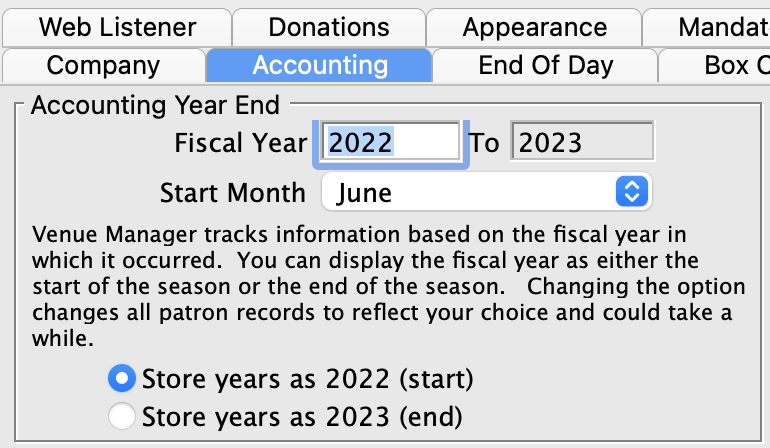
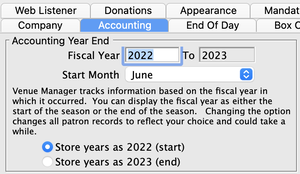
Organizations need to run the Year End Rollover within a few days of passing their organizations fiscal year-end date. In Theatre Manager the fiscal year-end date is set inside the Accounting tab of Company Preferences. The date set in Theatre Manager should be identical the organizations fiscal year-end.
Running the Year End Rollover does the following:
- Current year monthly financial totals are moved into the previous year monthly totals.
- Donations that were deferred for the next fiscal year are transferred from deferred revenue to earned revenue.
- Passes and Gift Certificates that were deferred for the next fiscal year are transferred from deferred revenue to earned revenue
- Hours attributed to volunteers/staff are rolled forward one year.
- Marketing statistics are recalculated to reflect the new fiscal year
Configuration Top
AMS Private Cloud Hosting Top
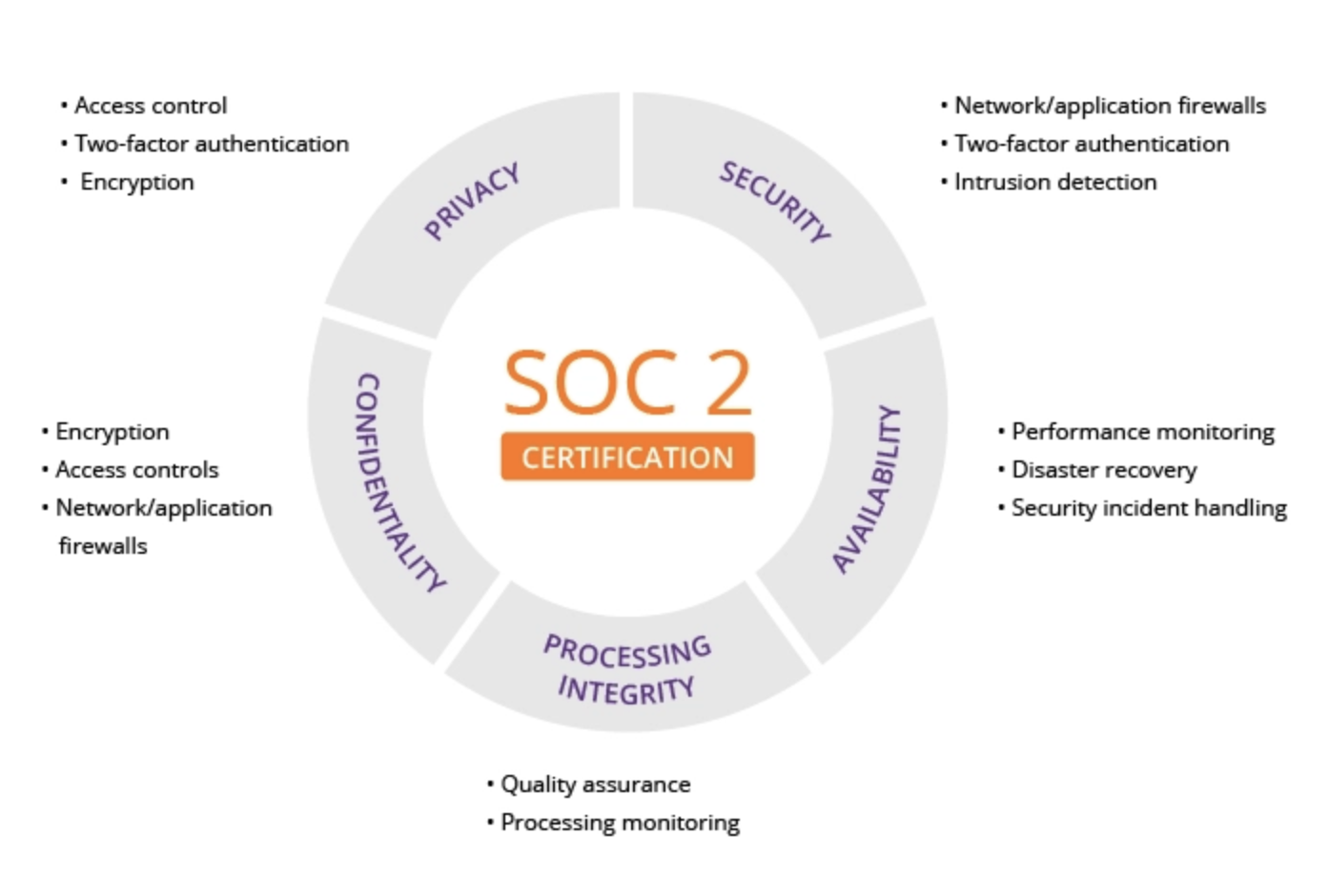
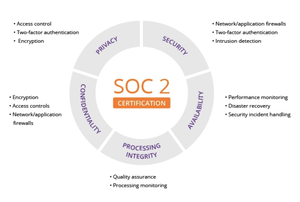
Since 2017, Artsman has hosted client databases in its own private cloud solution. Built on a proprietary linux implementation, Artsman has intentionally avoided third party platforms like Microsoft's Azure, or Amazon's Web Services, passing on those savings directly to clients.
All hardware and software required to run Theatre Manager and associated web sales are hosted in two data centers located in Vancouver and Montreal. Each data centre is SOC2 Certified and is maintained 365 days a year by the Artsman Operations Team. With a historical 99.9999 percent uptime, clients can view the Artsman Cloud Status, which displays the previous 90 days of activity and incidents.
Git Top
Git is a widely-used open source VCS software designed to coordinate work among programmers developing software. It securely tracks edits and provides group project workflow.
Here's a good summary from Simplilearn: "Git is a version control system used to track changes in computer files. Git's primary purpose is to manage any changes made in one or more projects over a given period of time. It helps coordinate work among members of a project team and tracks progress over time. Git also helps both programming professionals and non-technical users by monitoring their project files. Git can handle projects of any size. It allows multiple users to work together without having affecting each other's work."
Markdown Top
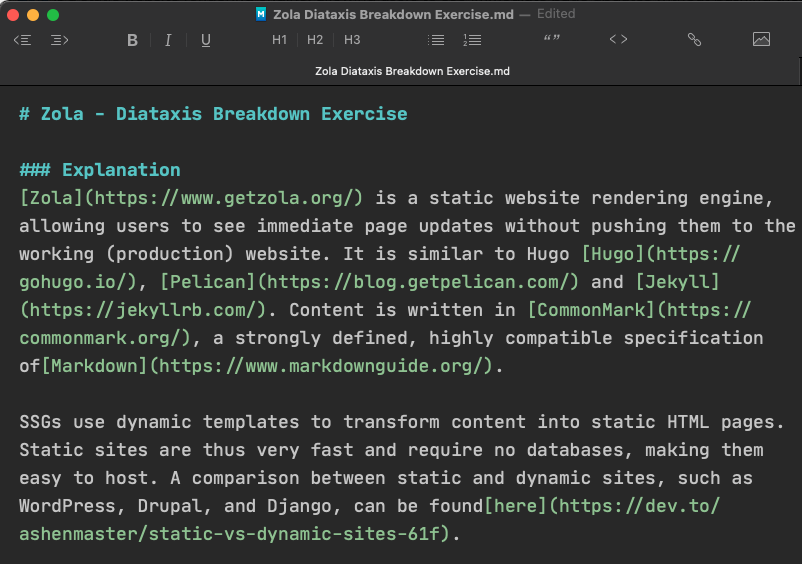
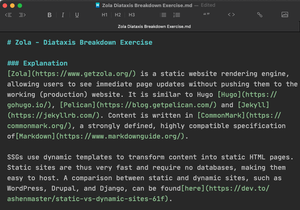
Markdown is a lightweight markup language that you can use to add formatting elements to plaintext text documents. Created by John Gruber in 2004, Markdown is now one of the world’s most popular markup languages.
Using Markdown is different from using a WYSIWYG editor. In an application like Microsoft Word, you click buttons to format words and phrases, and the changes are visible immediately. Markdown isn’t like that. When you create a Markdown-formatted file, you add Markdown syntax to the text to indicate which words and phrases should look different.
For example, to denote a heading, you add a number sign before it (e.g., # Heading One). Or to make a phrase bold, you add two asterisks before and after it (e.g., this text is bold). It may take a while to get used to seeing Markdown syntax in your text, especially if you’re accustomed to WYSIWYG applications.
For a full list of how to format Markdown syntax, click here.
Merchant Account Top
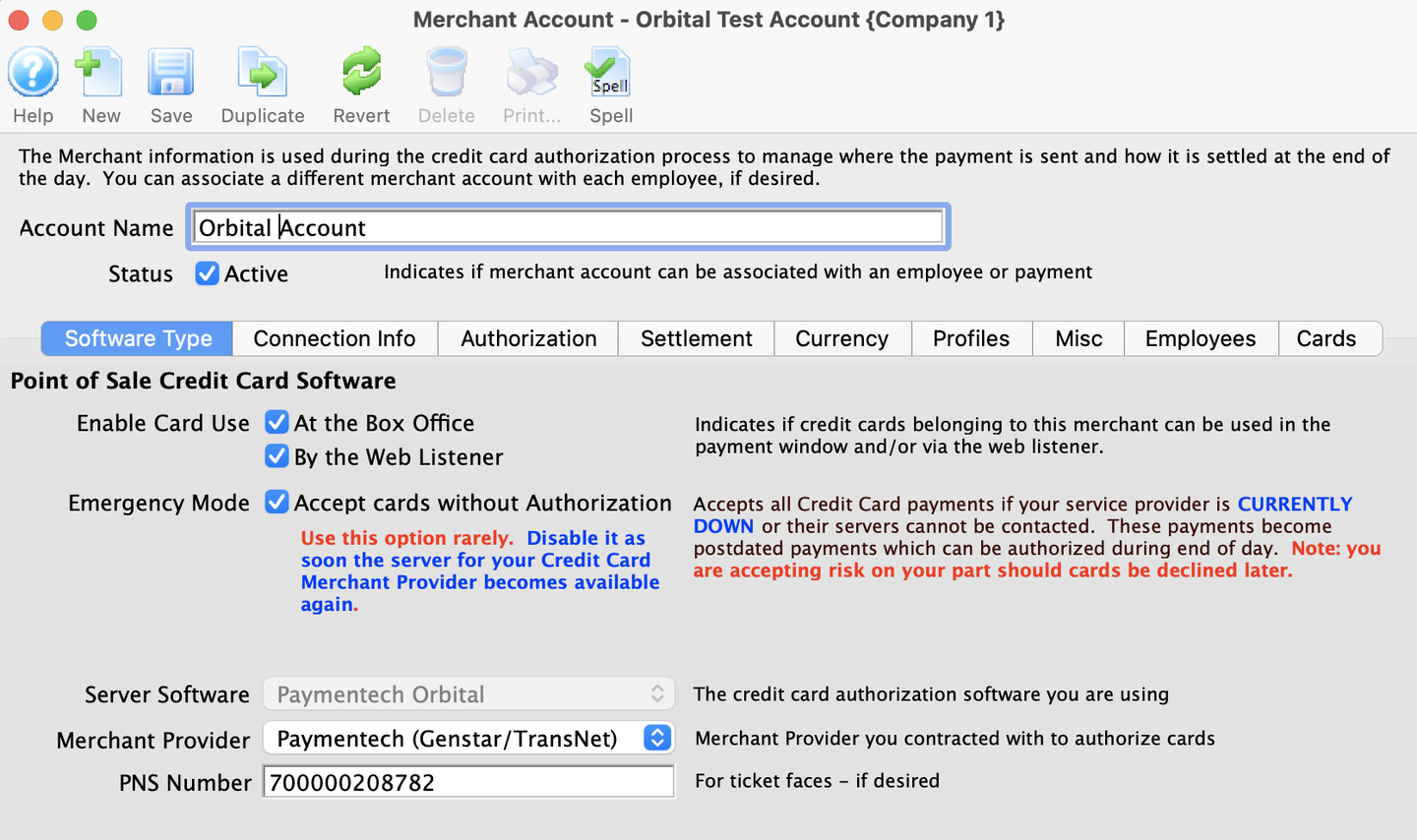
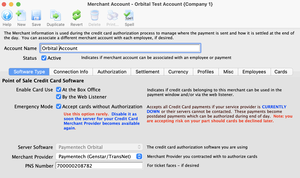
Merchant Accounts are used in Theatre Manager to:
- Provide the required details to communicate with the credit card processing provider
- Set up an Electronic Funds Transfer (EFT) Merchant so that you can take customer information and process repeated payments at selected back institutions. The banks supported by EFT are currently limited - if the setup does not show your bank, please contact support to see if EFT support has been expanded.
There are two types of merchant accounts:
- Credit Cards - which is used to describe how who processes your credit cards directly from Theatre Manager.
- EFT - Checks - which is used to tell Theatre Manager how to process direct deposit checks to a bank. It supports some banks (contact us if you wish to use this and your bank is not listed). EFT can also be used as a convenience tool for recurring (but not direct deposit) transactions from an external agency like Canada Helps.
PCI Compliance & Security Top
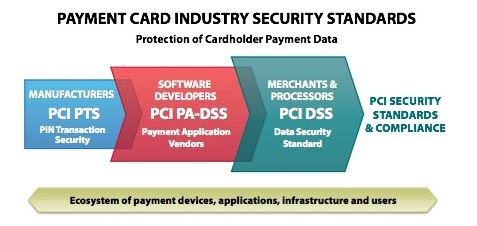
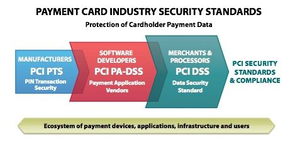
The Payment Card Industry Data Security Standard (PCI DSS) is a set of requirements intended to ensure that all companies that process, store, or transmit credit card information maintain a secure environment. It was launched on September 7, 2006, to manage PCI security standards and improve account security throughout the transaction process.
An independent body created by Visa, MasterCard, American Express, Discover, and JCB, the PCI Security Standards Council (PCI SSC) administers and manages the PCI DSS. Payment brands and acquirers are responsible for enforcing compliance, not the PCI SSC.
Meeting compliance requires some due diligence and is determined by the PCI compliance level guideline an organization wants to attain.
Depending on how your venue processes transactions, Theatre Manager can be setup to support Schedule 'A', 'A-EP', 'B','C', or 'D'.
PCI Levels Top
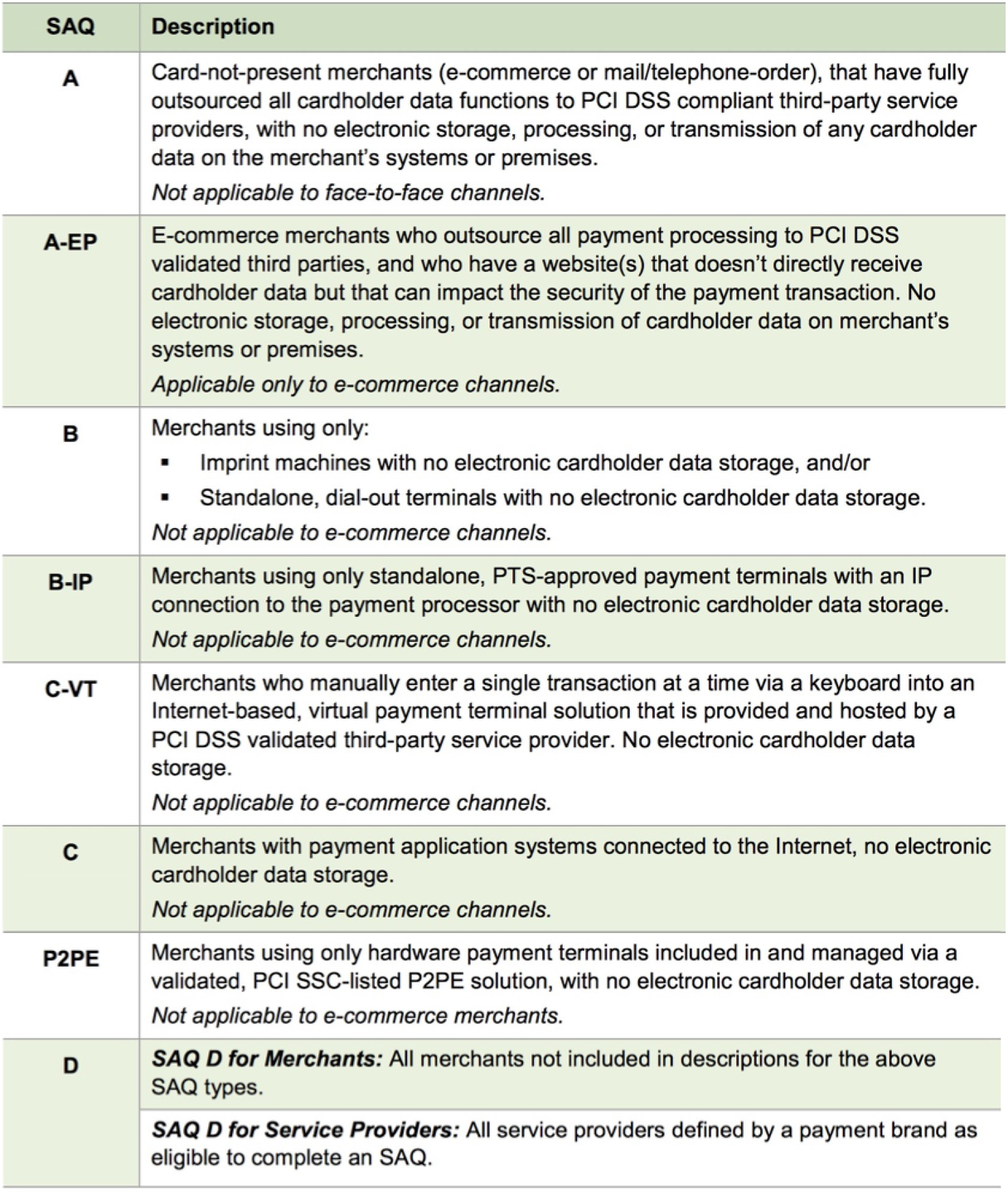
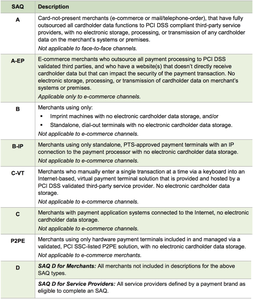
The PCI council has established 4 main levels for merchant compliance; schedules 'A', 'B','C' or 'D' with some variations at each level. You can use the table to the right to help determine the level that applies to your organization below.
Theatre Manager can achieve compliance for
- schedule 'A' using Moneris Hosted Payment Page and only web sales with no cardholder data storage
- schedule 'B' or 'B-IP' if using pin pad machines for walk up and using Moneris Hosted Payment Page for web sales with no cardholder data storage
- schedule 'C' using a setting in System Preferences for venues processing cards through TM for both box office and e-commerce -and- no storage of cardholder data
- schedule 'D' using a setting in System Preferences for venues processing cards through TM for both box office and e-commerce -and- storing cardholder data for any purpose such as recurring transactions and post date payments.
- schedule 'A-EP' Merchants using hosted payments for web sales like Moneris
Plugin Top
A custom software component that creates a unique function or appearance for a specific client. AMS can build plugins for clients to save employee time and create streamlined patron experiences online. Some common client plugin revolve around custom information needs for education course sales and automated group or subscription sales behaviors.
REST API Top
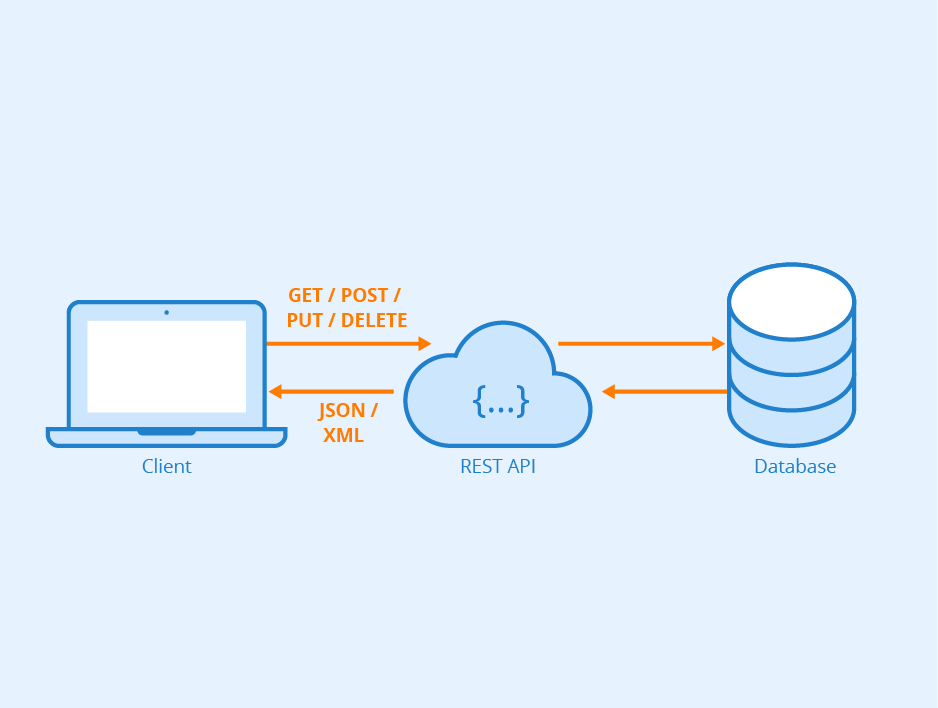
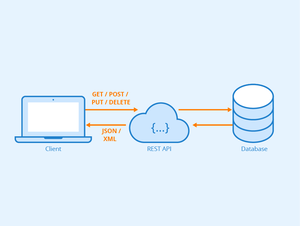
REST APIs provide a flexible, lightweight way to integrate applications, and have emerged as the most common method for connecting components in microservice architectures. At the most basic level, an API is a mechanism that enables an application to access a resource within another application.
The Theatre Manager REST API feature allows access to an organizations database fields using a URL. This can be typed directly into a web browser or use in a program. Typically, this feature might be used by:
- Web developers who want to augment an organizations main marketing website, pulling specific data from Theatre Manager like dates and performance times of upcoming shows.
- Selected employees to pull specific data or aggregated date for analysis.
- Producers that want to see sales data for their upcoming event.
The data can be delivered in a number of formats like plain text, (tab and comma delimited), JSON, EXCEL, HTML and some graphical formats.
Self Hosted Top
An Artsman term to denote clients are using their own hardware, at their own venue, to run all software required by Theatre Manager.
TM Server Top
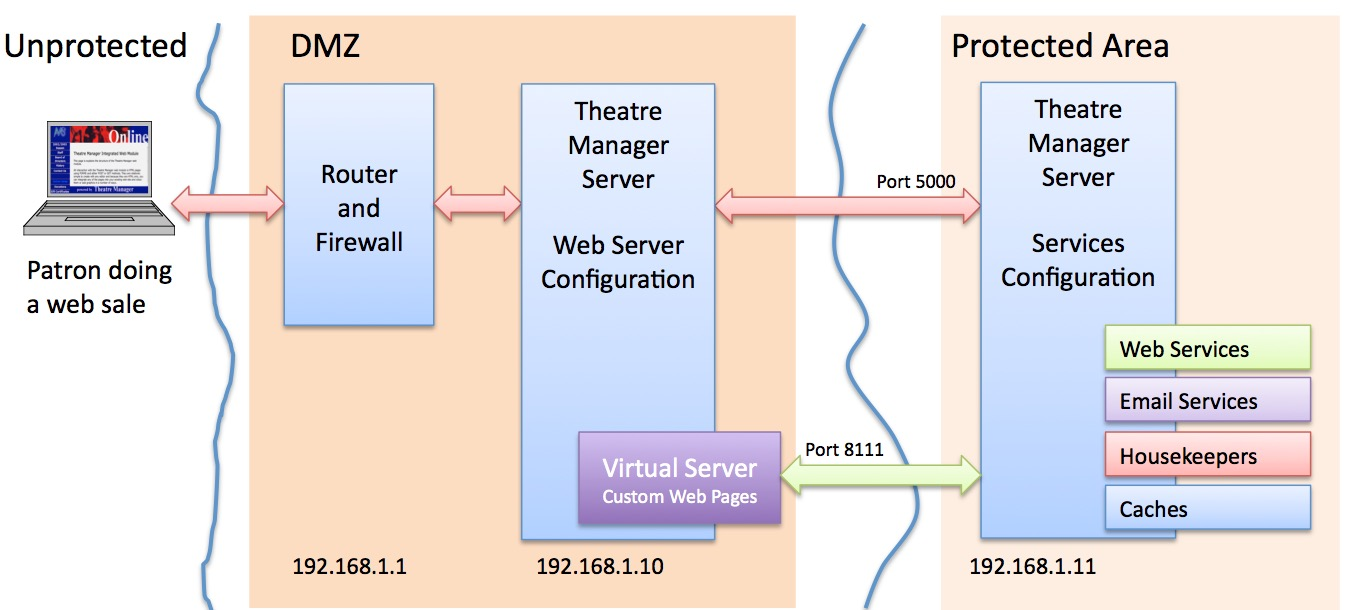
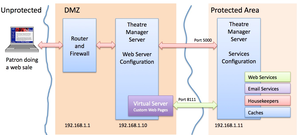
Key software that underpins communication between the Theatre Manager Database and the Ticket Site's Web Sales. TM Server functions for both web server (using NGINX) and web services.
For clients running on the Artsman Private Cloud service, the TM Server and all other web services are set up and maintained by Artsman. For Self-Hosted clients, the TM Server application is installed on an organizations physical hardware (ie, client's own server).
Training Database Top
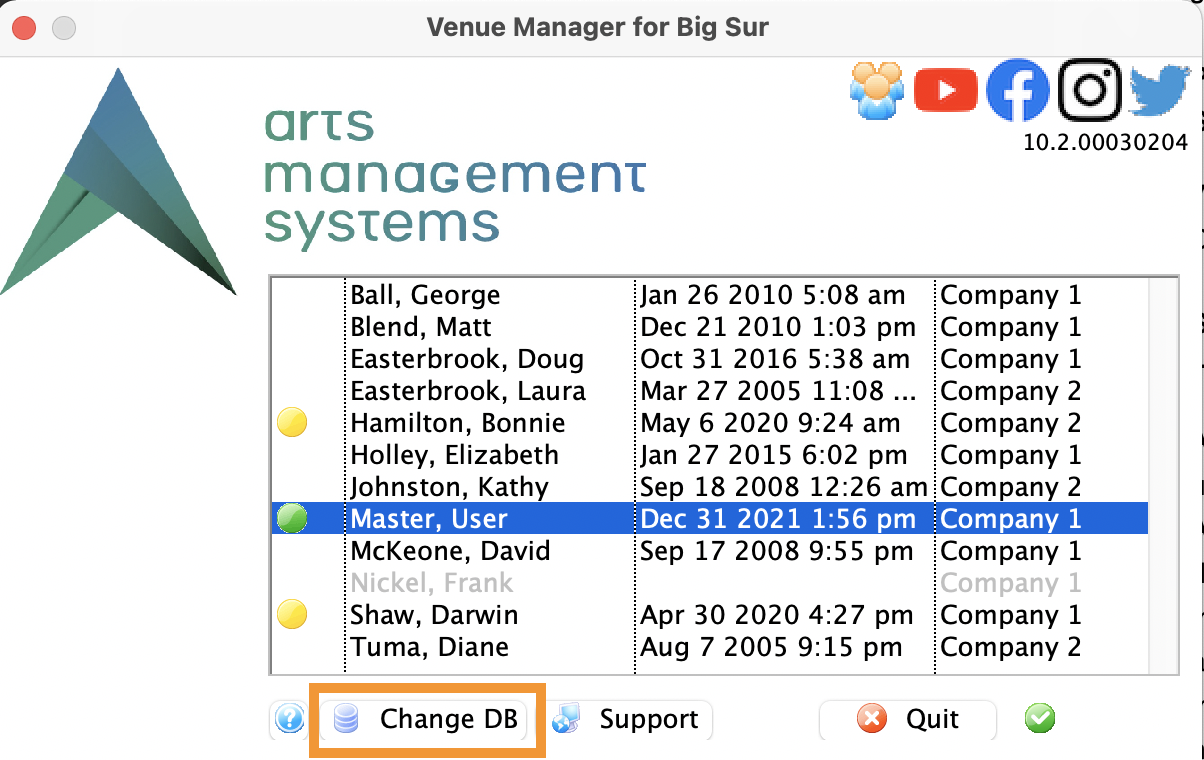
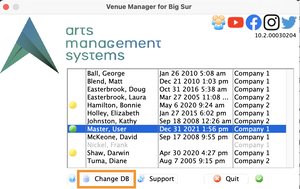
A database specifically designed for practice in Theatre Manager. This database does not post financial transactions, interact with an organizations payment processor, or send emails (or other communications) to patrons. The Training Database needs to be setup by Artsman support ( support@artsman.com), and can be selected by clicking the Change DB button on the Theatre Manager login window.
Version Control Software Top
VCS is a type of software that helps track modifications to files, usually with features to allow multiple editors to work on a project simultaneously. Bitbucket has a nice summary: "A version control system or VCS, also known as revision control or source control system, is a software utility that tracks and manages changes to a filesystem. A VCS also offers collaborative utilities to share and integrate these filesystem changes to other VCS users." AMS cloud clients use the popular VCS tool Git to make Ticketing Site customizations.
VPN Top
VPN stands for Virtual Private Network. It's a method of securely extending private network access across public or shared networks so that a remote computer can behave as if it were locally connected to the private network. It may be helpful to think of VPN as a secret tunnel connecting a device in location A to a server in location B.
Communication Top
Letter Top
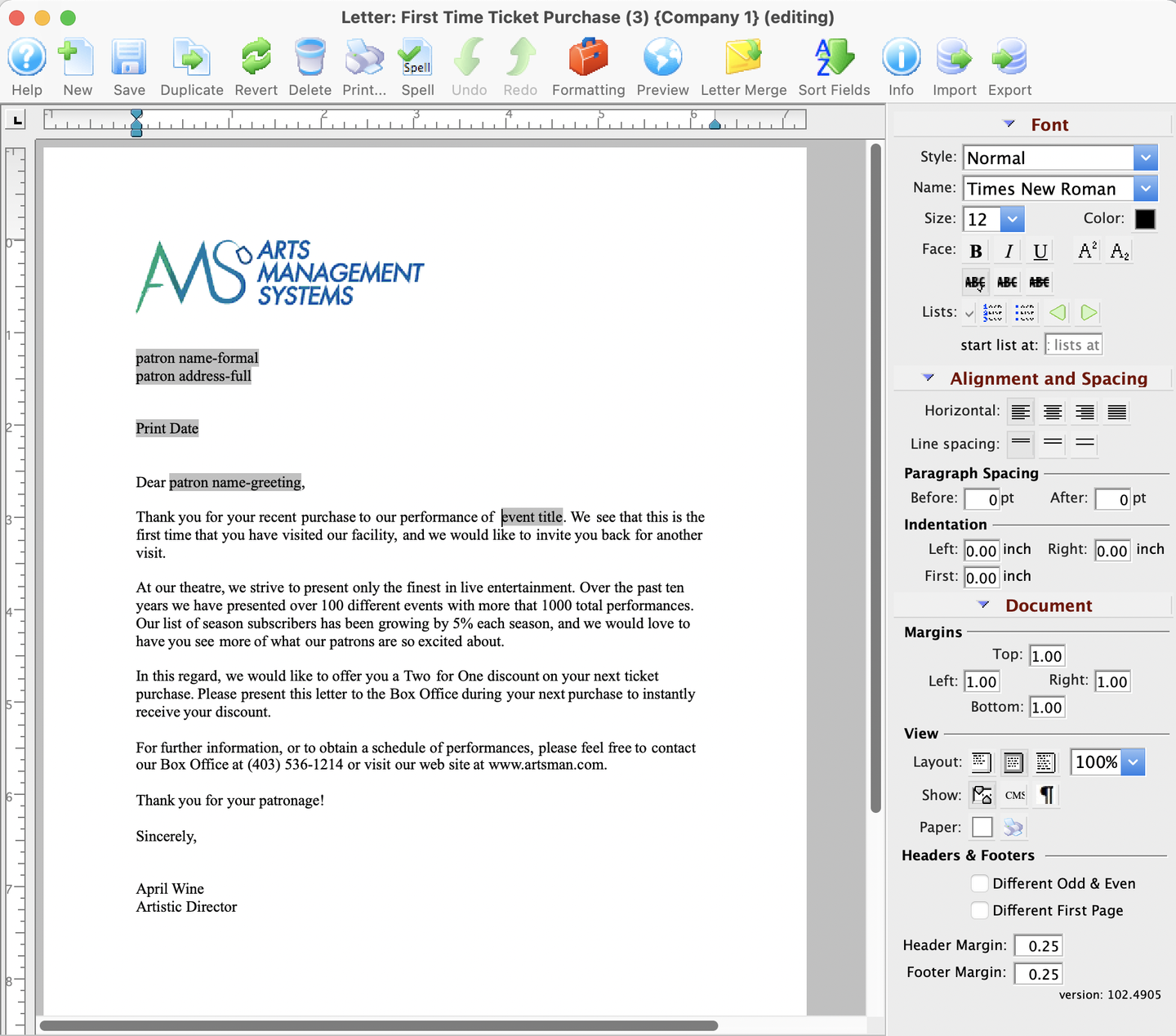
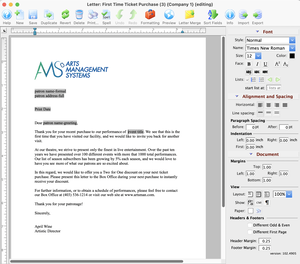
A Letter is a letter written from a template, rather than being specifically composed for a specific recipient.
Although letters are generally intended for a wide audience, many letters include stylistic elements or features intended to appear specifically tailored to the recipient. Often, Letters do not change.
For example, a user may automatically send a letter to patrons when they order tickets for the first time. This letter could include:
- instructions on how to find the facility
- information on upcoming events
- a thank you for purchasing tickets, or,
- making a donation.
A Letter may be attached to a patron directly or mailed to every one on a mailing list. Emails in Theatre Manager work in exactly the same way. An email is just a Letter that is sent as an email, rather than via the mail.
Mail Merge Top
Also known as Merge Letter, this process connects the contents of a Letter with an organization's database. This allows users to include customized data fields within the Letter, including (but not limited to):
- Name Options, like First Names, Last Names.
- Date Options, like date the letter was printed.
- Ticket Options, like seating details for an upcoming performance.
- Donation Options, like amount of the last donation.
Data Analysis Top
Aggregate Data Top
Aggregated data is a collection of individual data points put together in such a way as to provide a sorted and/or summarized view. Aggregated data is how people visualize information to answer questions, gain insights, or conduct analysis. For example, if a teacher has a dataset of student exam grades for a course, they could aggregate it in a variety of more useful ways than a simple listing, perhaps total score per student, average score for the class, or lowest score for each exam date. By comparison, see individual data.
Database Query Top
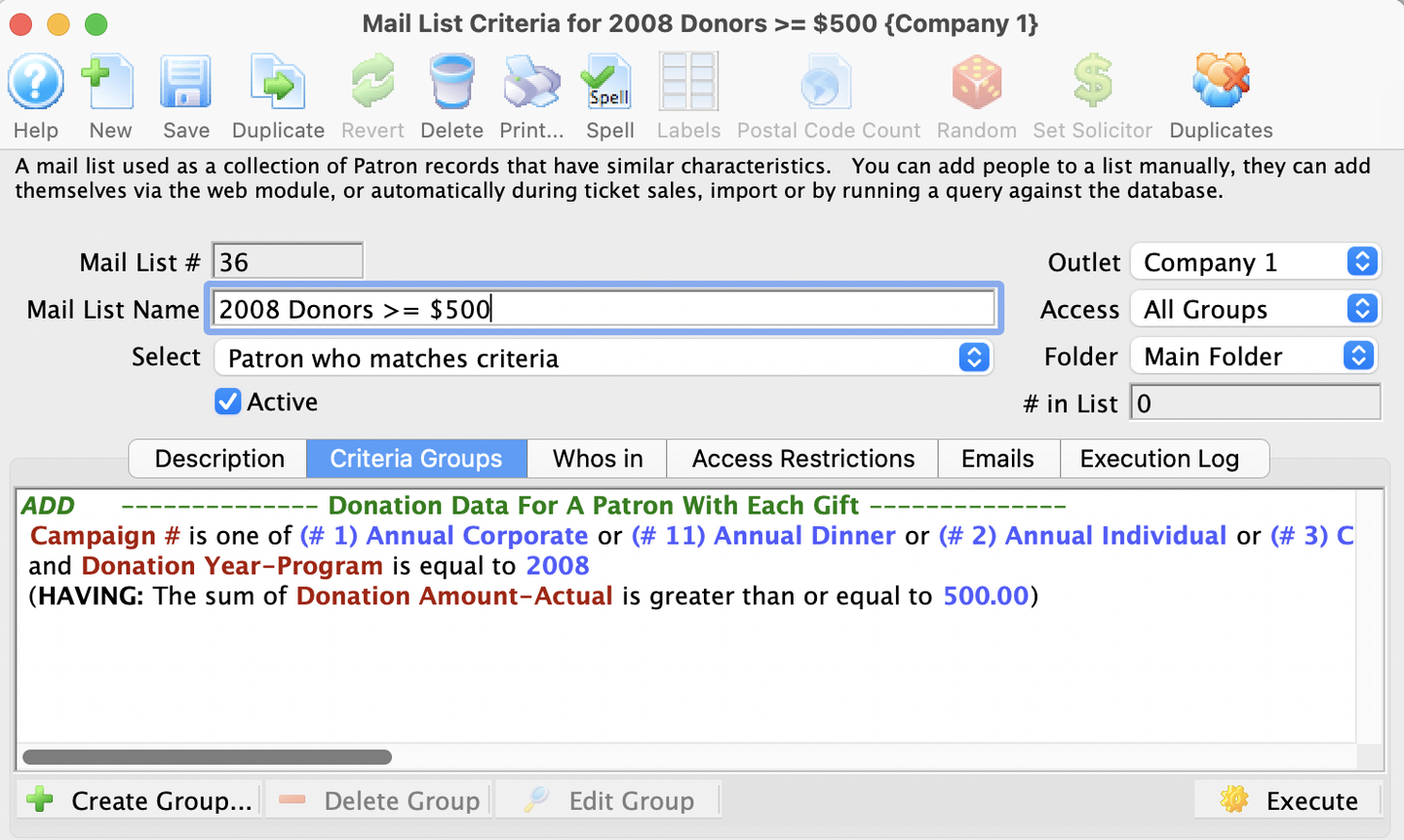
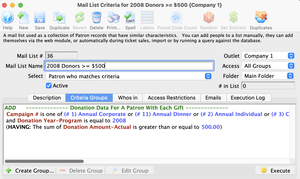
Also referred to as Search Criteria, a query is the primary mechanism for retrieving information from the database. A query is a set of questions presented to the database in a predefined format. Queries are found throughout Theatre Manager, but are most often used to build a Mail List or generate a Report.
Individual Data Top
Also called row-level data or, colloquially, raw data, individual data refers to each discrete piece of information within a dataset. For example, in a set of student exam grades for a course, every separate test score is a piece of individual data. A listing of this data would display a single row of information for every test score, perhaps with separate columns for student name, test date, and final score. By comparison, see aggregate data.
Statistics Top
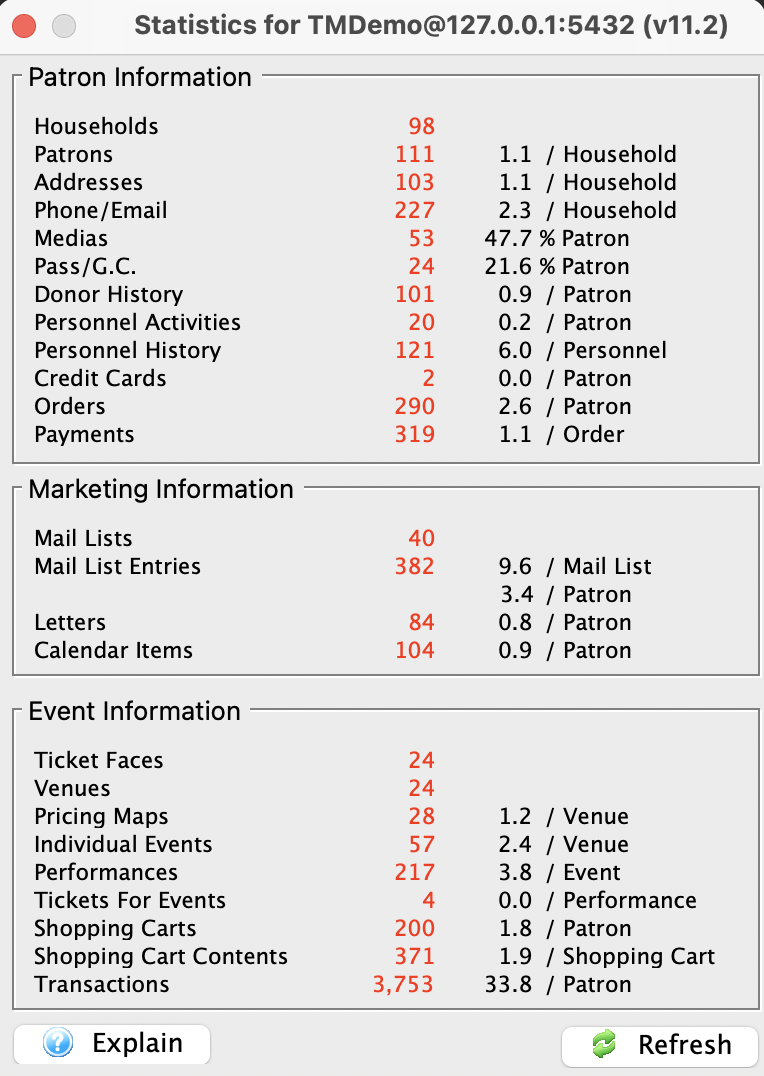
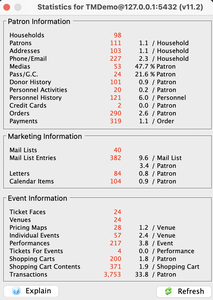
The science of collecting and analyzing numerical data in large quantities, in this case for a Theatre Manager database. Found inside the menu bar by going to File >> Statistics, the Statistics windows offers a summary for patron, marketing and event information, calculated over the lifetime of the database.
Donations & Charitable Giving Top
Calendar Year Top
Calendar year is a field with a value automatically derived from the date of each donation for tax receipt purposes. Other donation date fields are program year and fiscal year.
Donation Top
Donations are charitable gifts to a nonprofit organization in which the donor receives nothing of value in return. In accounting terminology, donations fall under the category of unearned revenue.
- Monetary donations include cash and gifts of stock.
- Grants can be considered a special type of monetary donation in which a government agency or a private foundation provides money to a nonprofit, usually contingent upon completion of a specific project.
- In-kind donations are non-monetary contributions such as free physical goods or services. Colloquially, a single donation is often referred to as a gift.
There are two big categories of donations, be they monetary or in-kind:
- Restricted gifts are earmarked for a specific purpose or use (e.g. scholarships for education camps, replacing theatrical seats, repairing a roof, etc.) and cannot be used for other purposes. Best practice to meet legal requirements is to hold restricted donations in a restricted fund, an account used only for the earmarked purpose.
- Unrestricted donations are given without special instructions and can be used by the nonprofit in any way it deems necessary, including general operations.
In the theatre industry, organizations can be private or public, commercial or non-profit, state-sponsored or independent. Thus, the donation profile in the industry is highly dependent on the individual business structure of the organization. Nonprofit independent theatres in America and Canada historically rely heavily on donations. The exact standard percentage depends on many factors, but it is not unusual for such an organization to sustain around half of its revenue from unearned sources, including donations.
Gift In-Kind Top
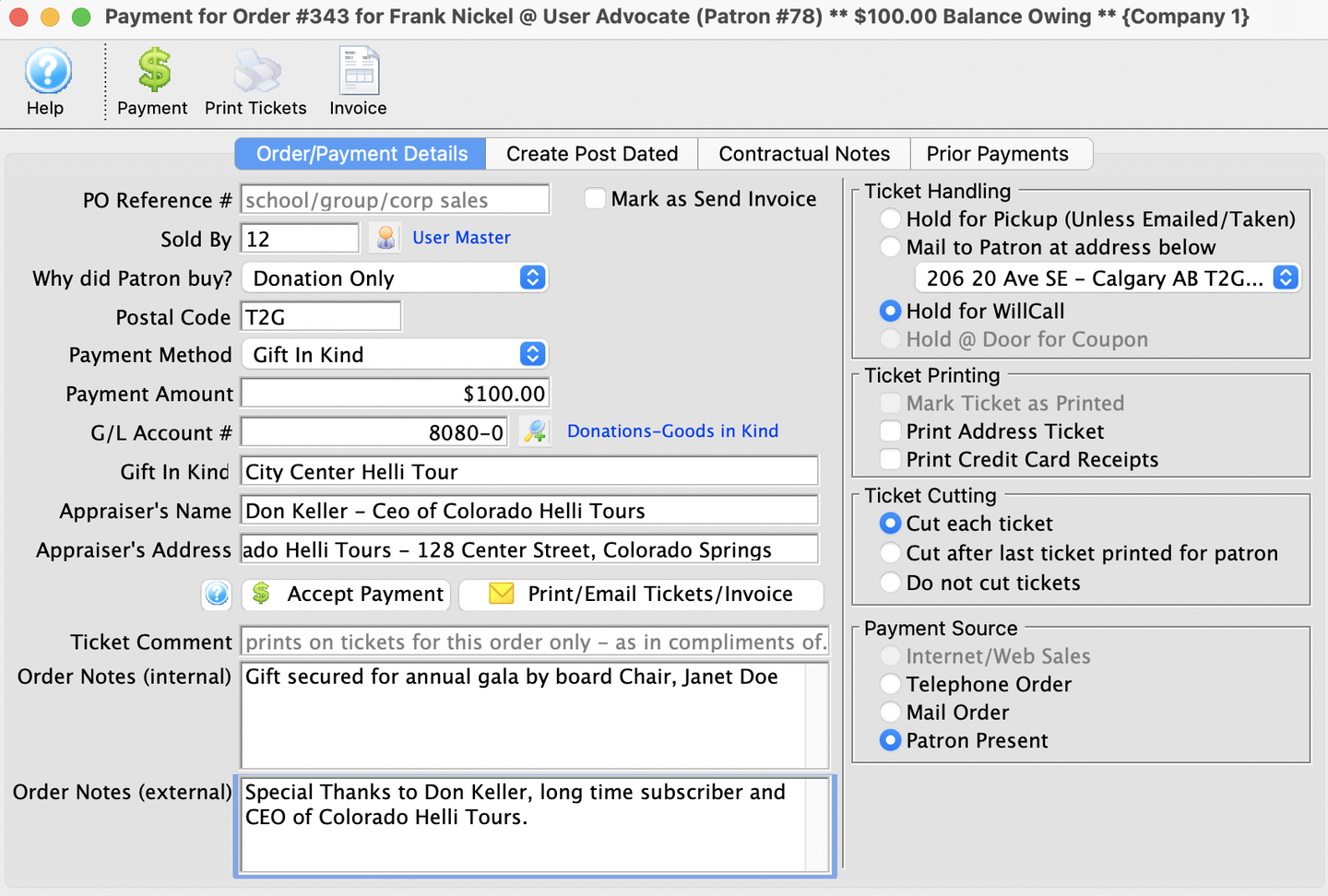
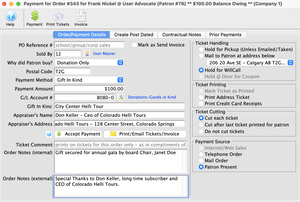
Gifts in kind, also referred to as in-kind donations, is a kind of charitable giving in which, instead of giving money to buy needed goods and services, the goods and services themselves are given. Gifts in kind are distinguished from gifts of cash or stock, and can include donations of land, buildings, marketable securities, equipment, furniture, vehicles, promotional items, and raffle or auction prizes.
Theatre Manager can be configured to process Gifts In Kind, however it is recommended that organizations refer to their tax accountant and board Treasurer before beginning to issue official tax receipts. Government rules vary as to how gifts are appraised, with some places allowing self appraisal, and others allowing self-appraisal only up to a certain dollar amount.
Hard Pledge Top
Used in the tracking the progression of prospective donors. Selecting Hard Pledge will commit that amount to the End-of-Day (EOD) process. Theatre Manager consider a Hard Pledge as money an organization can count on receiving in the future. Typically, Hard Pledges are used when patrons close to an organization, like a board member, convey a donation they've solicited.
Planned (Legacy) Giving Top
Planned giving, also called legacy giving, refers to larger estate gifts or bequests upon the passing of an individual (as per their will). It can take many forms, including combinations of stocks, donations from a living will, etc.
Pledge Top
Donation pledges are donors' promises to give a certain amount of money to an organization over a set amount of time. Donors can make pledges that are conditional, meaning payment will only be made once a condition is met, or unconditional with no strings attached.
Program Year Top
Program year is a date tracking option for donations in Theatre Manager. Generally, program year is the same as an organization's fiscal year. However, you can set an arbitrary year in the future or past in order to track totals differently than fiscal year. Changing program year has no effect on financial data. Often, when tracking program year differently than fiscal year, this field can be used as selection criteria in the Program Listing Report. Other donation date fields are calendar year and fiscal year.
Recurring Donation Top
A Recurring Donation is a series of gifts given repeatedly on an open-ended schedule with no specific commitment from the donor. The concept is based on encouraging donors to donate on a regular basis, for example on a monthly basis. The donor can then decide to end the arrangement at any time, or, pay indefinitely.
Recurring donations are treated as earned revenue when they are received - just as if a normal cash donation was received. There are no Accounts Receivable as each gift has a pre-defined payment method that will be used for each occurrence of the gift.
Soft Credits Top
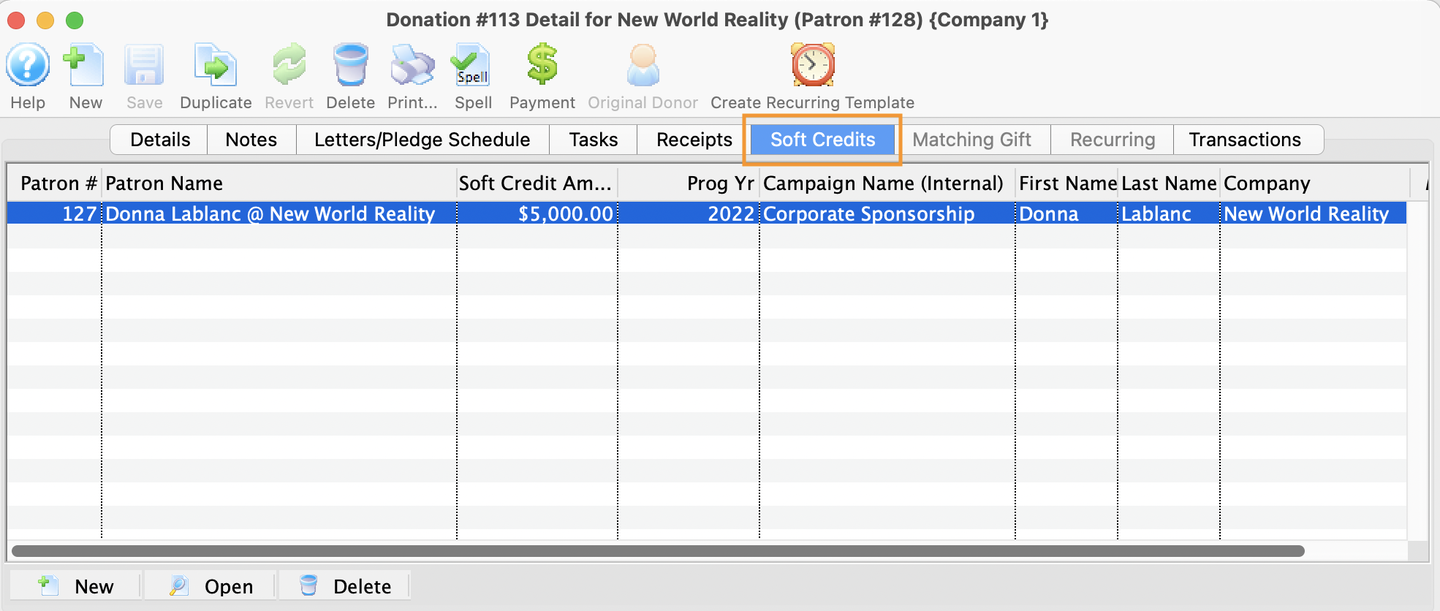
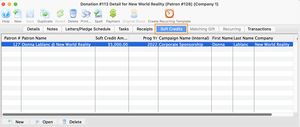
A soft credit is a way to give recognition to someone who 'encouraged' the original donation * without entering a real donation*. Soft Credits are often used to track donors who prefer to give via a foundation or corporate sponsorship.
For example, Donna Leblanc sits on your Board, and also works as a real estate agent. Donna successfully lobbies her firm to become a new corporate sponsor, brining in $5,000. While the real estate firm wrote the check for $5,000, it is important to credit, or link, Donna with that revenue. In this scenario we can use the Soft Credit system to link that corporate sponsorship to Donna's profile.
Theatre Manager keeps totals for soft credits just like it does for actual donations. Almost all donation reports have the ability to show soft credit data.
Soft Pledge Top
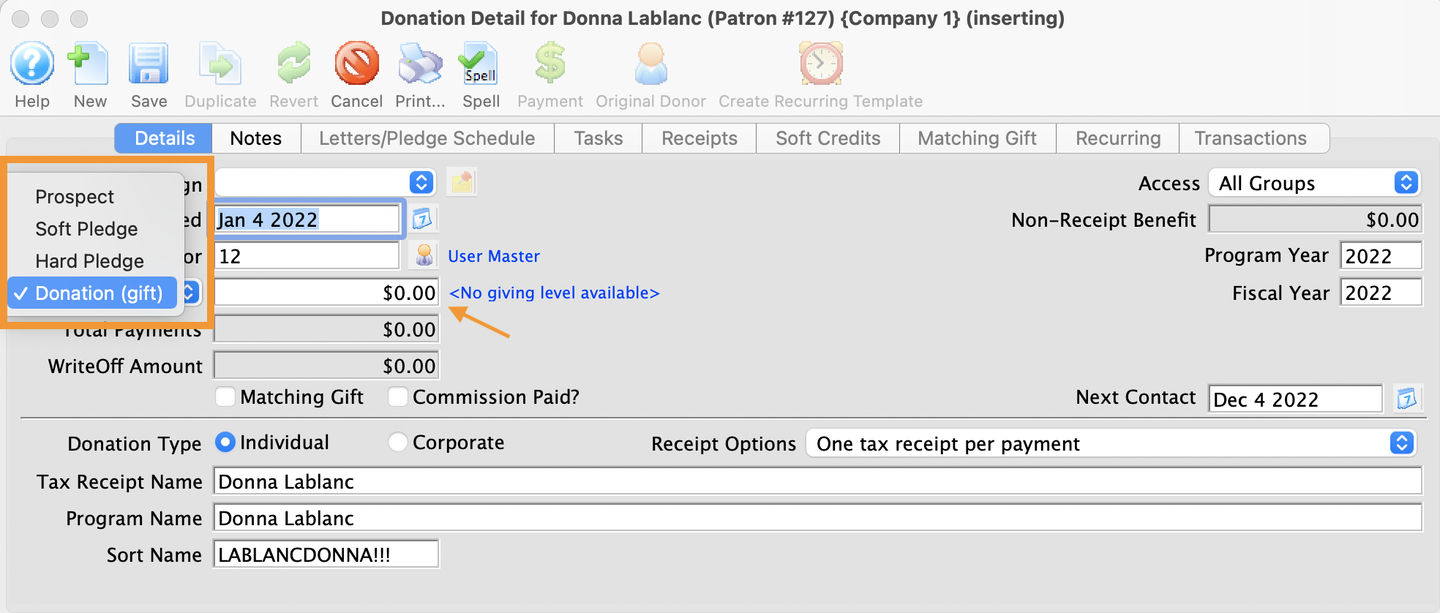
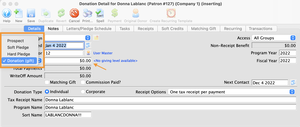
Used in the progression of tracking prospective donors. A Soft Pledge is typically used to denote a donor with a less than 50% chance of actually donating.
Theatre Manager uses the following Donation Types:
- Prospect
- Soft Pledge
- Hard Pledge
- Donation
Both Prospect and Soft Pledge entries DO NOT post to GL. Users can input Prospect and Soft Pledges amounts with nothing showing up on the End of Day because Theatre Manager does not consider them real donations.
Tax Receipt Top
Also called donation receipts, tax receipts are an official document provided by an organization to a donor confirming receipt of a gift and its value. Often subject to regional or federal laws, the exact requirements for donation receipt content and delivery differ from place to place. Regardless of the specific details, however, a donation receipt should provide legally recognized evidence of charitable giving for donors to complete tax filings and support any audit of those filings. Typical information includes: donors' full name, organization's legal name, organization's nonprofit identification number, date of donation(s), and amount(s) received. If something of value was provided to the donor in exchange for a donation (e.g. a fundraising gala registration in which the donor received a free dinner and drink), this exchanged value may need to be removed from the donation total on the tax receipt.
Employees Top
Logon Level Top
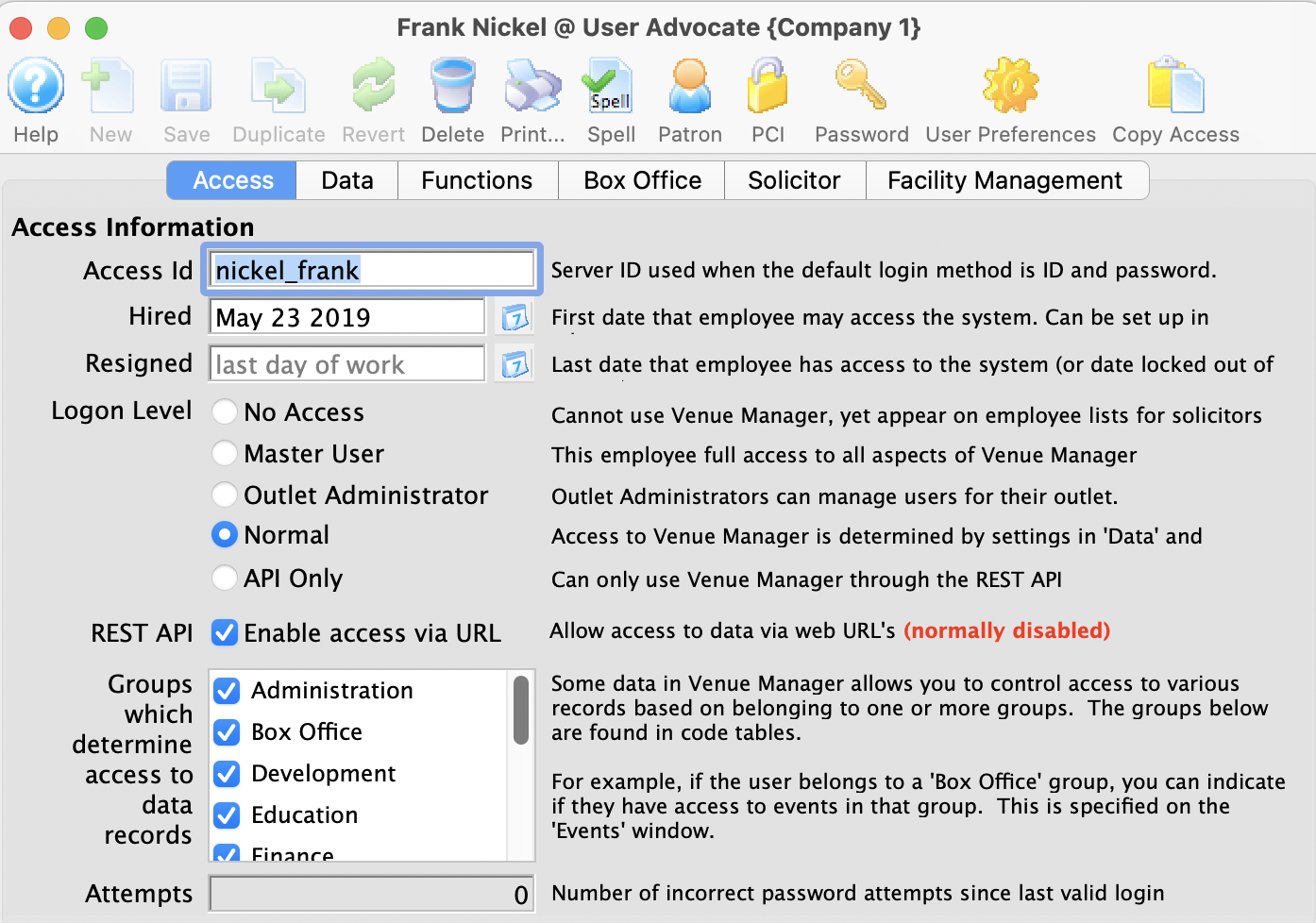
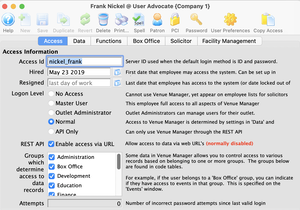
Indicates the general user level of the employee, broken down into 5 basic categories:
- No Access: An employee with no access cannot use any aspect of Theatre Manager. Their username will not appear on the login window, it will however appear on any employee list report unless specifically excluded. A user may be given no access because they have resigned, or the company wants a database of their employee's even if some employees never use Theatre Manager.
- Master User: This employee can access any part of Theatre Manager. They are denoted by a bullet beside the username in the login window. The Master User has unrestricted access to all modules of Theatre Manager, including the ability to change the access levels of other employees and themselves.
- Outlet Administrator: Administrative access over an outlet. They are denoted by a percent symbol beside the username in the login window. Outlet administrators have access to all modules of an outlet excluding system settings.
- Normal User: Access to windows and functions can be restricted in various parts of Theatre Manager. These restrictions are set in the Data -and- Functions Tabs.
- Normal User: is not able to alter their own access levels.
- API Access Only: This level is explicit in that is only allows access to data in the database via the Data and Functions Tabs. The Normal User is not able to alter their own access levels.
Events Top
Auction Top
Auctions are a form of public sale where people bid on a good, offering the price they are willing to pay for it, and the highest bid "wins" the right to sale. Live auctions are real-time (in-person or virtual) sale events with auctioneers/moderators to manage the bidding war and push up the price. Silent auctions have no such set time frame or salesperson. Instead, the goods are displayed ( in-person or virtually) for an extended period of time and people browse and write down their bids, usually in a format that allows everyone to see the current highest bid. Winning bids are identified and announced at the end of the time period.
Auctions, particularly silent ones, are very common fundraising activities for nonprofit theatres and a frequent feature of galas. A fundraising auction operates just like a commercial one except that the bids are for donations. This works financially because the items to be auctioned are typically donated to the organization for this purpose by individuals, businesses and other nonprofits.
Class Top
In Theatre Manager, a class is what patrons attend when they've purchased a course.
Control House Top
Every Season Package requires a Control House. The Control House is a completely separate event from the rest of the season's performances and acts as the place saver for the patrons favorite seats. It is used to track:
- The evening they will be attending.
- Where the patron prefers to sit.
- The price/promotion to use for each seat.
- If the patron renewed their seats (or not).
A Control House is used by Theatre Manager to allocate seats to patrons for the upcoming season.
Course Top
In Theatre Manager, a course is what the organization sells to the public. Courses are comprised of a number of classes.
Event Top
While play and event and show sometimes get used interchangeably in casual conversation to refer to an on-stage theatrical production, some organizations draw distinctions between them. Generically (and in AMS lingo), an event or show refers to a specific production (e.g. Hamlet by TheatreABC in 2015), which may have one or more performances (e.g. 10/5/2015 at 2PM and * 10/5/2015 at 8PM*).
Some organizations are very specific about what types of events or shows they offer. When this specificity is required, here are some popular types of events:
- Play
- Straight plays are told only through visuals and dialogue between characters, with occasional music clips between scenes or as part of the onstage action.
- Musical
- Musicals are modern-day adaptations of the opera form and function as plays that include song and dance numbers performed by the characters as part of the telling of the story.
- Opera
- Operas are stories told through the same visuals and character portrayals as plays or musicals, but all the words are sung as lyrics and there is no spoken dialogue. A form originally created in Italy, they historically feature symphonic scores, complex melodies, elaborate costumes and sets.
- Ballet
- Ballets tell a story solely through the ballet dance style developed by the French, without any sung lyrics or spoken dialogue. They often feature a symphonic score and support the story with elaborate costumes and lighting effect.
- Dance Show
- Sometimes show is specifically attached a non-balletic presented dance event, such as modern dance or world dance. While these may include a suggested storyline, multimedia elements and/or some sung lyrics or spoken dialogue, the primary communication is human movement.
- Concert
- Concerts are music-centric (typically with little to no corresponding storyline) events featuring a band or soloist or full symphonic orchestra.
- Reading (or Staged Reading)
- Staged readings are presentations of a play or musical (often a new work) in which the actors portray the characters and read/sing the script without costumes, lighting, set pieces, etc. Often the actors perform solely by reading from a physical script while seated.
- Special Event (or Fundraiser)
- Sometimes the phrase event is specifically used to denote a non-performance group activity, typically to raise funds for a cause of some kind.
- Festival
- Festival is often used to describe a public event with a theme that includes multiple mini-events each with its own start time and/or location (e.g. an evening concert, some daytime public workshops, food vendors, specialized merchandise stands, etc.).
- Conference
- Conference refers to a festival-format event that is usually not open to the public at large, but rather offered only to a specific group of people with a shared work or extracurricular interest.
- Game or Competition
- Sports venues (and some theatrical venues) may present an athletic competition or game. For example, theatres have a good technical setup for virtual gaming competitions and some flexible seating spaces that aren't arenas can be setup for wrestling or body building demonstrations.
- Speaker (or Lecture)
- Speaker or lecture events describe formal speeches, moderated interviews or panel discussions. While there may be basic lighting and set elements and audiovisual presentations, the primary content is people talking to the audience about a topic of expertise or public interest.
- Livestream
- A livestream event can take many forms, so the word is often used as a descriptor of another event (e.g. livestream ballet or livestream play) if that event is offered to viewers onscreen in real time.
- Movie (or Film) Showing (or Screening)
- If the event is primarily presented onscreen, mostly prerecorded, it is called a showing or screening.
Event Code Top
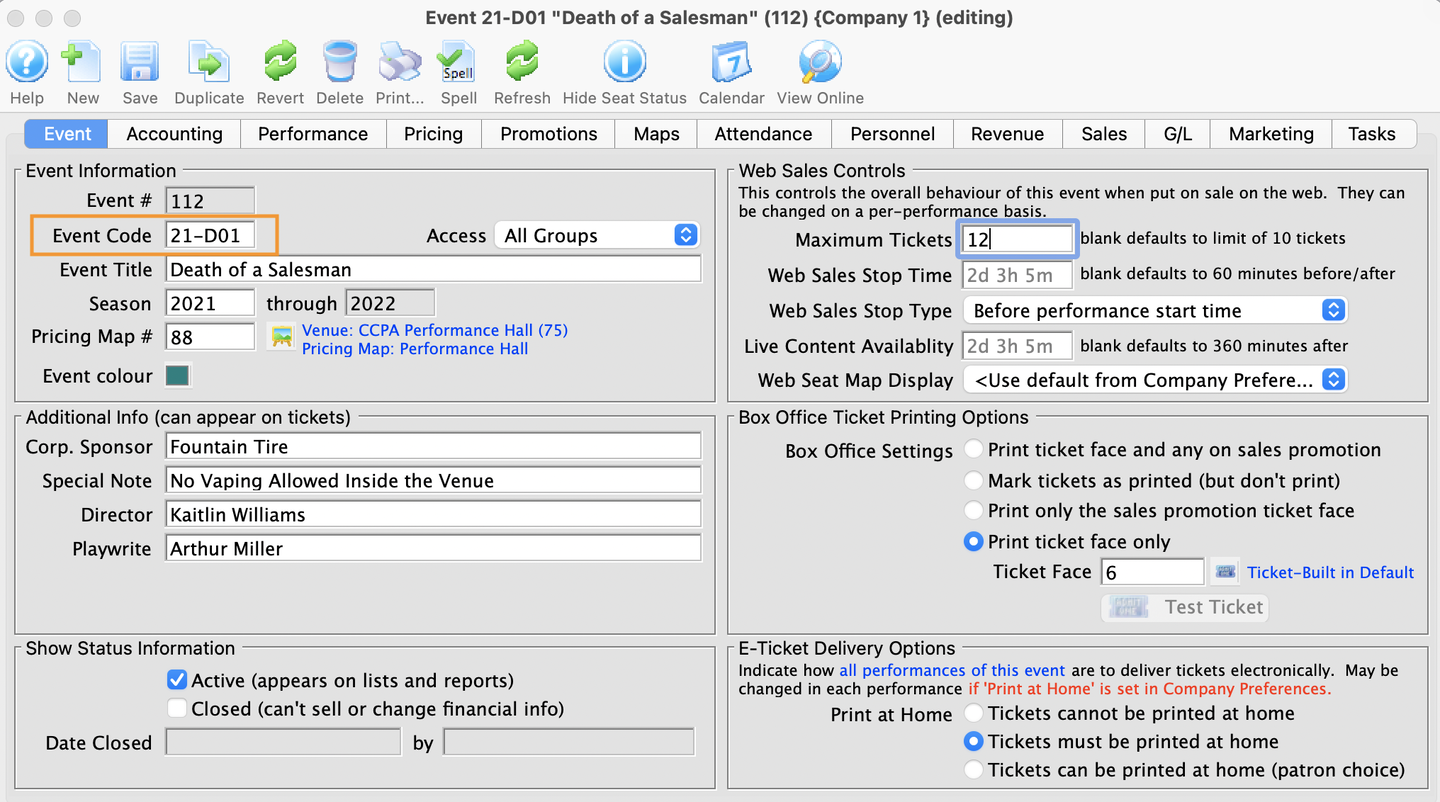

Event Codes are found on the Event Window and are limited to 6 characters. This field can can only contain numbers and letters, with special characters, like "#" and "%", excluded.
Event codes are created by the user and should follow some kind of logical naming convention. Artsman recommends Event Codes start with the fiscal year of the performance, followed by the sequence of the event in a season. For example, the 5th event in the 2022 season could be referenced as 22-05. This allows for quickly generating reports on events by year.
If there is more than one venue, or, the organization has different types of series, for example a main-stage and a second stage series, letters that reference the name or type of event can also be helpful. Sample Event Codes from various organizations are below:
- 22-01 / the 1st event of the 2022 season
- 23-05 / the 5th event of the 2023 season
- 25-D03 / the 3rd event in the 2025 season, Death of a Salesman
- 22-J08 / the 8th event in the 2026 season for the "Jazz" series
Event Number Top
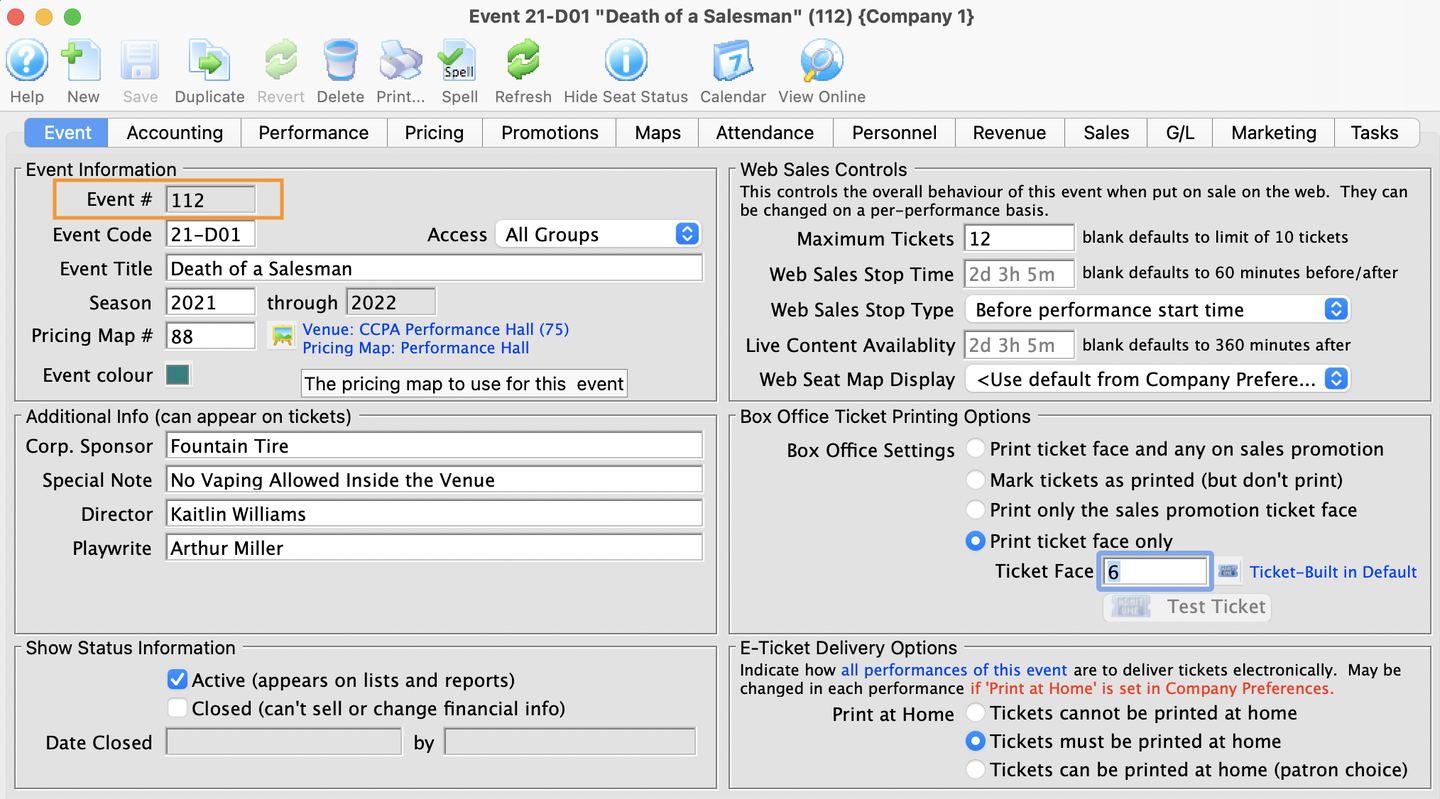
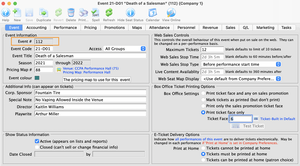
Event Numbers are found on the Event Window and are automatically generated by Theatre Manager at the time of creating the event. This field is often referenced by web developers to generate direct links from outside sources like social media, to take patrons directly to the event inside the ticketing site. Once an event is built the Event Number cannot be edited.
FOH Top
FOH stands for front of house, which refers to the full set of jobs and activities involved in welcoming an audience to an event, seating them, taking care of them, and getting them back out at the end of the event. The scale of this work depends on the size of the venue and the specific organization. Common job tasks include:
- house management
- overseeing audience seating
- troubleshooting pre-show issues
- coordinating with the production team on when to start each act
- public emergency management
- concession and bar sales
- ticket scanning
- pre-show and post-show cleaning
- sometimes quite the feat, especially if confetti, streamers, balloons or excessive alcohol are involved
- ushering audience to their seats
- often involves troubleshooting seating issues with the house manager and box office
- traffic (human or vehicular) control
- many theatres have complex car and bus drop off and parking protocols for school performances
Gala Top
Galas are a traditional (and often annual) fundraising event for nonprofit organizations. While each event is different, they usually include food and drink, an exclusive presentation of some kind, and supplementary fundraising activities such as a silent raffle or auction. Registration prices for a gala are historically on the high end as a significant portion of the registration cost is a donation to the organization. Galas also typically include a honoree induction or recognition ceremony for major supporters or important community members.
General Admission Events (Festival Seating) Top
General Admission, also referred to as Festival Seating events, only sell a quantity of tickets at the time of sale. Patrons are seated on a first-come, first-served basis.
Live Streaming Top
A live-streamed event is a program offered virtually over the internet, but in real time rather than prerecorded. During the pandemic, the nonprofit arts world relied heavily on offering livestreamed content instead of traditional live content. AMS met this demand by adding embedded Ticketing Store streaming to TheatreManager's event setup options, building customizations for some of the most popular livestreaming services (YouTube, Vimeo, etc.) AMS clients could thus offer livestreamed content with a paywall that directly connected to their existing patron and event databases and online patron store accounts.
Reserved Seating Events Top
Reserved Seating, also referred to as "allocated seating", mean patrons are given a row and a seat number at the time of sale. Patrons therefore know before the event where they will be seated.
Run Top
The run usually refers to the length of time that an event has performances. So if an event opens on a Tuesday and closes that following Sunday, the run is 6 days or a week. Sometimes people will specify the exact number of performances, such as a 7-play run.
When run is used in the context of a single performance, usually as runtime, it's the length of time that the performances takes (from a public audience perspective), such a 2 hour and 10 minute runtime.
Seat Holds Top
A seat hold, usually hold for short, is a way of restricting sale access to a specific seat without having to assign or sell it to a placeholder account. Most ticketing systems have a built-in hold feature that allows seats to be held under different codes or tags that have specific meanings for the organization. For example, a kill is a type of hold used for seats that have been removed or blocked and are therefore unavailable throughout the run of an event.
Facility Management Top
Consumable Top
A consumable is an item that is permanently used up. These would be items from inventory such as cups, concession items, etc. It would not include permanent items like tables, projectors or chairs.
In Theatre Manager's Facility Management module, a resource is marked as consumable in the Task Resource setup.
Facility Management Top
Facility management refers to a branch of professional management focused on the intersection of buildings, physical structures, people, processes and technology. In the theatre industry, the term may refer to two different spheres of work, one of which is focused on the production end (rigging, sound, lighting, etc.) and one of which is focused on the non-theatrical components (network, plumbing, security, traffic flow, etc.). In both cases, effective management includes highly detailed schedules, complex logistics, and advanced technological skills.
At AMS, the term refers to a specific module built for TheatreManager that provides project and task management features (including meeting invites, gantt charts, calendar views, billing services, resource tracking and volunteer management) that connect to the core software's patron, venue and event data.
Filters Top
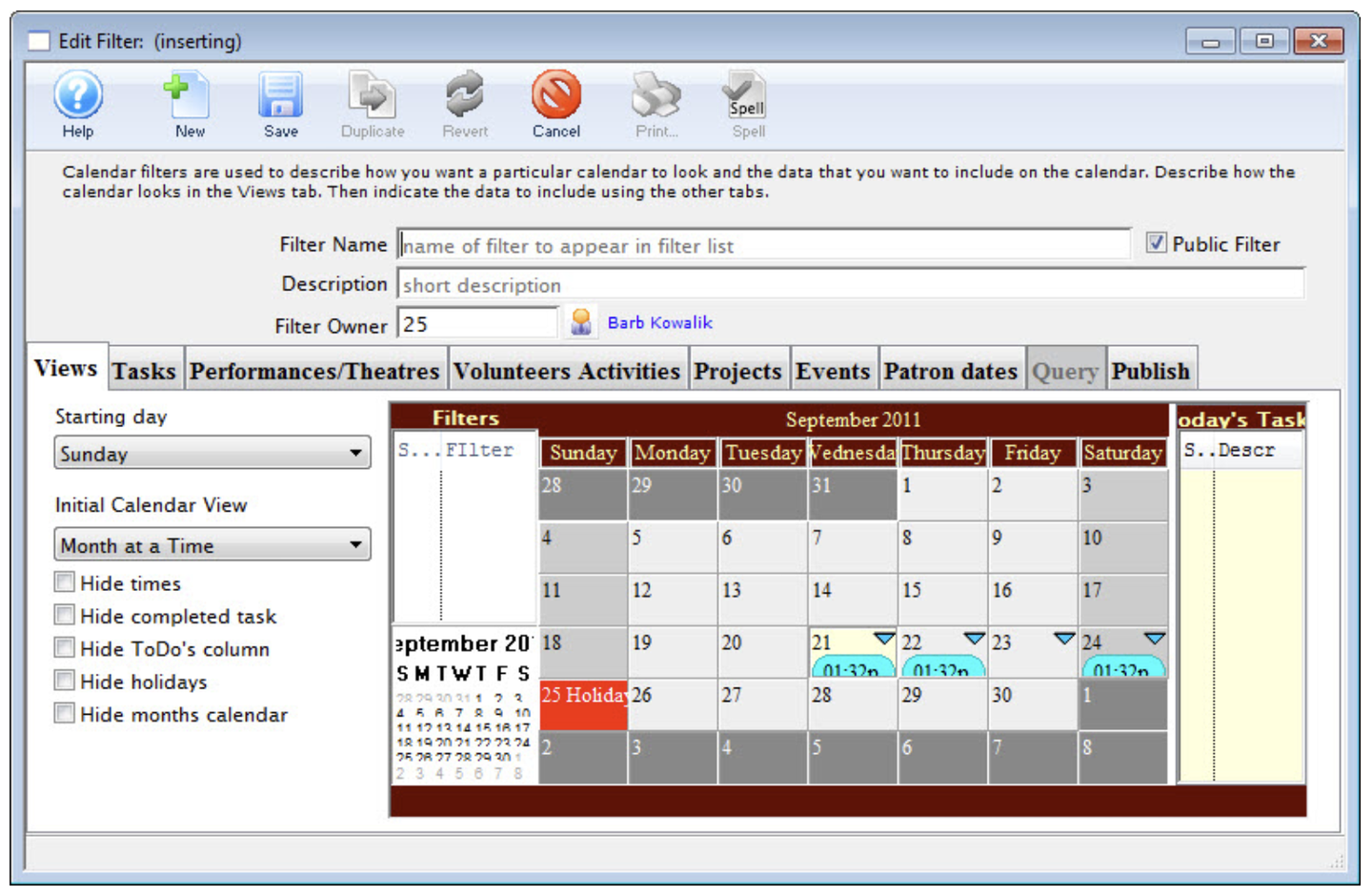
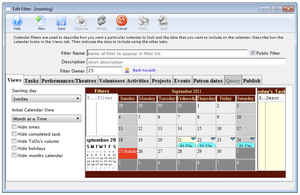
In Theatre Manager's Facility Management module, filters can be created to determine which information to show on a given calendar or report. Filters are useful to describe how a particular calendar should look and the data it should display in the calendar. Users can set filters to show information only to them, or to be viewable by a group, or to all users in the system.
Floor Plan Top
A floor plan can refer to different diagrams for different theatrical positions, though all are created as though seen from above, typically in 2D. A production team typically uses a detailed floor plan of the stage, grid, fly system and backstage area when designing sets or planning for a traveling production. Facilities managers use floor plans of venue buildings (rooms, hallways, etc.) for traffic flow, ADA accommodation planning and building management. Box office and administrative staff sometimes use the term floor plan interchangeably with seating map or seating plan. In this case, a seating plan is an aerial diagram of a venue's audience seating, which includes visual indicators (typically with a legend or key) for things like: individual seat locations and names, entrances and exits, aisle locations and names, pricing tier indications, stair locations, column or other visual obstruction indicators, etc.
Gantt Chart Top
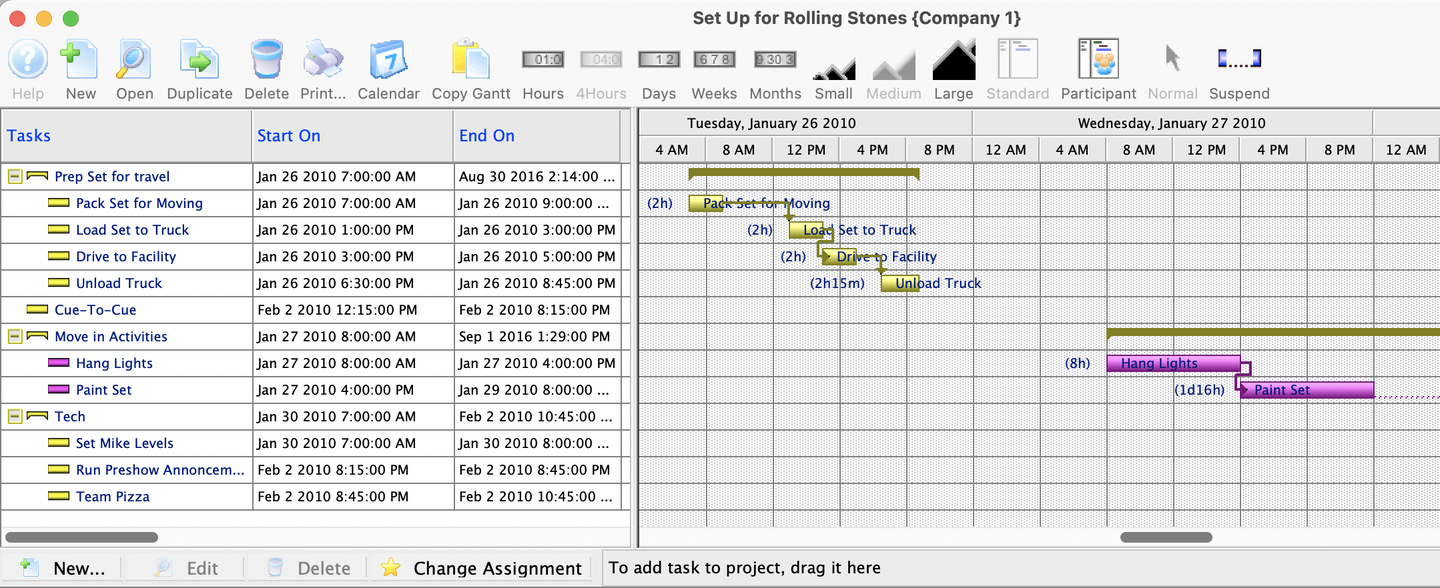
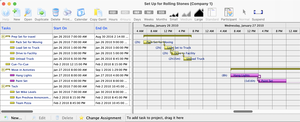
A Gantt chart is a graphical representation of the duration of tasks against the progression of time. A Gantt chart is a useful tool for planning and scheduling projects, these charts often including resources, people, and dependencies.
Project Types Top
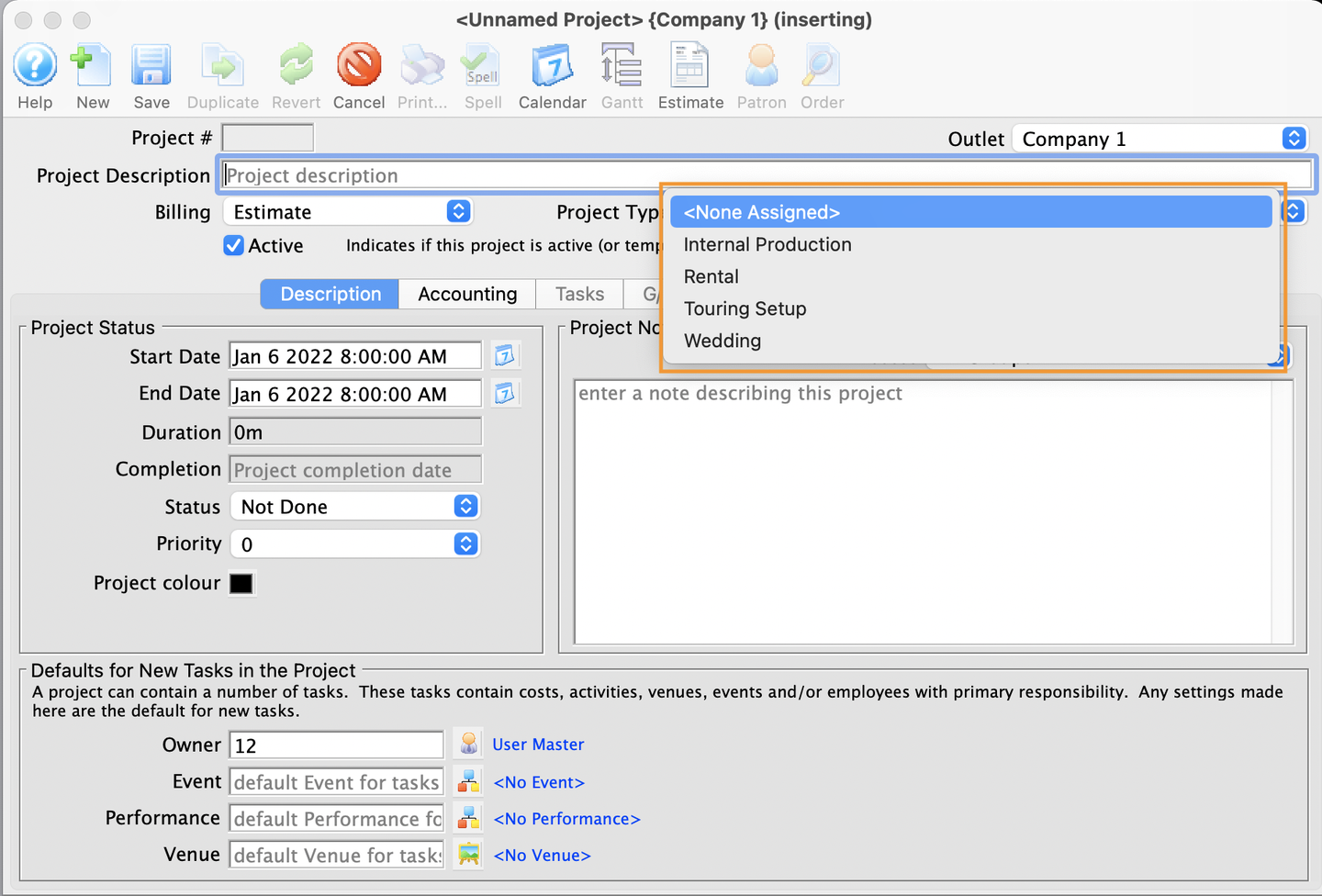
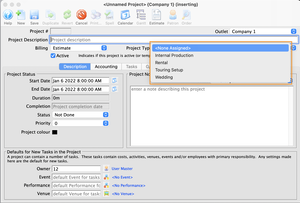
Project Types are set up in Setup >> System Tables >> Code Tables >> Facility Project Types. Using Project Types allows you to groups similar kinds of projects together. For example, an organization might have internal productions, outside rentals, summer weddings, and touring productions to coordinate on an ongoing basis. For these events, Project Types could be created to help track and generate reports.
Resource Top
A generic term, a resource could refer to any object, space or capacity that an organization can deploy to accomplish its mission and/or provide to others for a fee as a source of revenue.
In Theatre Manager, resource refers to a component of TheatreManager's Facility Management module that can be customized by the client to track, schedule and bill for physical resources. Commonly created resources are venue rental fees, audiovisual equipment to rent, merchandise to sell, tables/chairs to use/lend, etc.
Task Top
Tasks are the core of Facility and Workflow Management. Tasks can be associated with any number of people who are responsible for making sure it gets completed. Tasks can be reminders to yourself about upcoming deadlines, or they can be used to schedule your time. Tasks can have physical resources assigned to them that may be billed or not.
Calendars show tasks to be done in a variety of formats. Gantt charts (part of projects) show tasks that are associated with each other and the relationships between the various pieces. Invoices use tasks and the associated people and resources as line items in an invoice to bill clients.
Volunteer Top
Volunteers are individuals who donate their time and talent to a nonprofit organization. Though every theatrical organization is slightly different in their labor breakdown, common operational activities performed by volunteers include ushering, way finding, concessions sales, bartending, artist hospitality, and history keeping. For nonprofessional community theatres, volunteers also provide all or most of the board leadership, box office administration, show design, backstage technical work, acting and musicianship talent.
Volunteers are often a critical component of any theatre's labor force as well as a large source of donation support. Volunteer coordinators, either volunteers themselves or paid staff, typically schedule, train, manage and track a large and frequently rotating roster of community members. Most professional theatres include explicit volunteer recognition programs in which volunteers earn benefits, commonly free tickets, relative to the number of hours they work. Annual volunteer award ceremonies are also very common.
Industry Terms Top
Actors Equity Association Top
Colloquially called Equity or AEA, Actors Equity Association is a powerful US labor union of actors and stage managers, with sister organizations in the UK and Canada. In the industry, the moniker "professional" means that an actor, stage manager, or organization is in active contract with Equity. Equity plays a major role in setting standards for paid theatrical work conditions, compensation and benefits.
Agile Methodologies Top
In software development, agile methodologies are a set of practices designed to value:
- individuals and interactions (over processes and tools)
- working software (over comprehensive documentation)
- customer collaboration (over contract negotiation)
- responding to change (over following a plan)
Agile practices ideally encourage flexible teams and adaptive responses to changing product and client environments. According to Atlassian: "Instead of betting everything on a "big bang" launch, an agile team delivers work in small, but consumable, increments. Requirements, plans, and results are evaluated continuously so teams have a natural mechanism for responding to change quickly."
Board of Directors Top
A board is a group of elected individuals that serve in a governing body to represent shareholders in a for-profit or nonprofit. Nonprofit boards are responsible for the long-term health and strategy of an organization and board members often serve out of an internal commitment to the organization's mission. In the nonprofit arts world, most boards have an annual donation and/or fundraising requirement in addition to oversight responsibilities. While the specific duties differ considerably between organizations (for example, volunteer community theatres often have boards with highly involved operational committees while professional theatres tend to keep day-to-day activities off of board agendas), the general nonprofit board responsibilities include:
- financial oversight
- legal oversight
- executive level hiring and evaluation
- long-term strategic planning
- public reputation
- major fundraising and resource acquisition
Box Office Commissions Top
"Commissions the Presenter may be entitled to receive out of the Gross Box Office tax receipts (GBOR) to cover their internal ticketing commissions." (Robin Rothstein's The Road 101)
CRM Top
Customer Relations Management systems typically compile existing and prospected client information with custom tracking and management features to make it easier for businesses to target and acquire new audiences as well as retain existing clients. Most sales and service-driven businesses include a CRM software of some kind. Some big name ones include Salesforce, Monday, Pipedrive, HubSpot and Microsoft Dynamics.
DBMS Top
A (Relational) Database Management System is the software or program that interfaces with a relational database. Users view, modify, and administer the database records with this management software. The TM Desktop app is the DBMS.
Direct Company Charges Top
"Charges that are paid for 100% by the Show during an engagement. Some examples could be studio space rental at the presenting theater, Daywork, Telephone and Internet use, Lag bolts, etc." (Robin Rothstein's The Road 101)
Development Top
In the nonprofit arts, development is the most common term used for fundraising and membership activities. Development departments manage annual giving as well as capitalization campaigns.
Donor Churn Rate Top
Donor churn is a key metric most nonprofits track in their donor retention efforts. It's often calculated by dividing the total number of donors from last year by the total number of those same donors who haven't donation this year. This is a ratio version of LYBUNT, and it's usually reviewed along with the retention rate
Donor Retention Rate Top
Donor retention is a key metric most nonprofits track, usually calculated by dividing the total number of donors from last year by the total number of those same donors who donated this year. This is usually reviewed along with the churn rate.
Endowment Top
An endowment or endowment fund is a reserved monetary asset intended to ensure a nonprofit's long-term financial security and ability to its mission goals in the future. The principal amount is raised from large, purpose-dedicated donations that are then generally placed in an investment portfolio. Most large professional nonprofit theatres have an endowment fund and most mid-sized or smaller regional organizations do not.
Fixed Expenses Top
"A fixed amount of money required by the Presenter to cover internal expenses during the run of an engagement. Fixed Presenter “Packages” typically include, but are not limited to, box office running, venue rent, venue cleaning, administrative costs, local licenses and permits, Presenter’s League dues, ticket printing, show program up to a certain number of pages, utilities, etc. The Presenter is not required to show any tax receipts to the Producer for fixed expenses." (Robin Rothstein's The Road 101)
Four-Wall Deal Top
"A deal in which the Producer is essentially renting the theater from the Presenter. In a “four-wall deal,” Presenters typically receive their Fixed Expenses, ticket commissions, and possibly a very small percent of any overage. The Producer assumes all the risk in a four-wall deal." (Robin Rothstein's The Road 101)
Full Week Top
"Typically a standard eight show week with a dark Monday." (Robin Rothstein's The Road 101)
GBOR (GWBOR) Top
"Gross (Weekly) Box Office Receipts. Gross revenue before deducting taxes, fees and commissions." ( Robin Rothstein's The Road 101)
Gross Potential Top
"The maximum amount an engagement can possibly earn based on calculations involving ticket prices, seating capacity, and the number of performances." (Robin Rothstein's The Road 101)
Guarantee Top
"A deal in which the Presenter pays the Producer a guaranteed, fixed amount of money for an engagement, plus a percentage of the NAGBOR, sometimes called a royalty, or more commonly referred to in recent years as a “variable guarantee.” A “guarantee deal” also typically includes local documented expenses and fixed expenses, and Presenters usually receive a percentage of the overage. The Presenter assumes all the risk on a guarantee deal." (Robin Rothstein's The Road 101)
GUI Top
In software development, GUI (pronounced * gooey*) is an acronym for Graphical User Interface. It's the broad term for a front-end visual that allows user manipulation of electronic devices. It's most useful to think of GUIs in contrast to early computer development when most digital interaction happened through direct command line (CLI) or text entries.
Local Documented Expenses Top
"All local expenses related to the presentation of the engagement. Local Variable Expenses can typically include, but are not limited to, stagehands for load in/out and performances, wardrobe, equipment rental, insurance, ADA, advertising and local musicians. Presenters need to be able to provide tax receipts and back-up to the Producer for any costs incurred that fall under documented expenses." (Robin Rothstein's The Road 101)
LORT Top
LORT stands for the League of Resident Theatres, a prominent association of professional regional theatres in the US, administering bargaining agreements with the industry unions Equity (Actors Equity Association), SDC (Stage Directors and Choreographers Society), and USA (United Scenic Artists).
LYBUNT Top
A popular acronym for Last Year But Unfortunately Not This Year, a way of assessing donor retention by reviewing who gave in the immediately preceding period (usually annually), but not in the current period. A popular variation is SYBUNT, Some Year But Unfortunately Not This Year, which refers to donors who gave in any preceding year, but not the current one. LYBUNT lists are often pulled as a preliminary method for calculating donor churn rate.
Mail House Top
Mail or mailing house is a colloquial term for a business that offers design, printing, posting and direct mail services to other organizations. Most nonprofit theatres process small mailings in house for speed, but pay mail houses for large annual or special project paper campaigns. It's very typical for AMS clients to pull patron information based on donation or ticket history in TheatreManager and then send that exported data to a local mail house to merge and mail brochure or solicitation materials. Mail houses offer expertise, staff capacity, and postal service logistics. They also usually sell access to distribution lists for sending mail to whole zip codes, neighborhoods, etc.
Minimal Viable Product Top
In software development, MVP is a product development strategy that centers on an iterative process of experimentation and test feedback, much like the scientific process. An MVP has just enough features to be usable by early testers or users, who then provide feedback about further development. The goal is to avoid unnecessary development work by testing the assumptions behind a product design or business idea.
NAGBOR (NAGWBOR) Top
"Net Adjusted (Weekly) Box Office Receipts. The net gross after any taxes, facility fees and commissions." (Robin Rothstein's The Road 101)
One Nighter Top
"A one night engagement. Typically, tours that play smaller markets will be made up in large part of one-night engagements." (Robin Rothstein's The Road 101)
Overage Top
"The money that remains after all Presenter expenses, including producer payments (ie: guarantee, variable guarantee, etc.) have been deducted from the NAGBOR." (Robin Rothstein's The Road 101)
Parri Pasu Top
"A situation in a deal where middle monies owed to the Producer and Presenter are equally managed without any display of preference. For example, if a deal requires the Producer to defer his 10% Royalty and the Presenter to defer 10% of her fixed in order to cover documented expenses, each party will be fully reimbursed from the remaining monies. If the remaining monies do not cover the total amount of each party’s deferred monies, then both parties will be reimbursed equally out of whatever money remains in relation to the amount they each deferred, as opposed to one party being reimbursed more favorably than the other." (Robin Rothstein's The Road 101)
PostgreSQL Top
PostgreSQL, often pronounced postgres, is an open-source relational database system that conforms to SQL standards. A PostgreSQL database offer developers a wide array of customization options to meet their specific structure, integration, security, and backup needs.
Producing House Top
A producing house is a type of theatre that creates its own shows from the ground up. Whether the script is workshopped with theatre staff or the theatre purchases the rights to an already published script, the organization designs and builds everything else (costumes, sets, lighting, directorial choices, etc.). A production of the same play in two different theatres have the same dialogue, but otherwise are completely different.
Producing houses feed the rest of the for-profit and nonprofit theatrical industry, developing both new shows and new productions that gain traction regionally and then move to other markets, sometimes becoming national tours that travel and play in road houses.
Relational Database Top
A database is a structured digital collection of data items. In a relational database, these data items have pre-defined relationships to each other. Structured as a set of tables with columns and rows where each table contains information about a subset of the data, each column defines a single piece of information related to that subset (a number, a text string, a date, etc.), and each row is a unique instance of the subset. Every table has a column that acts as a key, allowing direct access to a single unique row. These keys are used to connect the various tables to each other. Most relational databases are written, modified, and searched using SQL. TM clients have PostgreSQL relational databases, either stored in local servers or on the Artsman cloud.
The term "database" is also sometimes used colloquially to refer to an entire DBMS.
Reserved Funds Top
Reserved or restricted funds are monetary assets help back from day-to-day operational use. As a general term, this could refer to an account setup for a major capitalization project, an endowment fund, donations earmarked for a special education project, etc. Though every organization has slightly different policies, it's common for reserved funds to require board approval prior to use.
Road House Top
Also known as a receiving house or a presenting house, is a theatre which does not produce its own repertoire but instead receives touring theatre companies, usually for a brief period such as three nights or a full week. The incoming company may receive a share of the box office takings or a minimum guaranteed payment.
West End theatres in London and most Broadway theatres in New York are also receiving houses, as the venue solely provides facilities to the incoming show even though the production may stay for many years.
Theatres which produce their own shows are known as producing houses, and some regional theatres will do both.
Season Subscriptions Top
Also called season packages or subscription packages, subscriptions are a traditional sales method for theatres and other live entertainment organizations. Each season (the annual period of event offerings by an organization), the theatre packages a select list of events and sells them together in a subscription. ( Read Playbill's obituary for Danny Newman for a quick, interesting history on the rise of subscriptions in midcentury North America.)
There are many variations, but in the theatre world, a traditional subscription includes a ticket in a set seating location (e.g. AA101) on a set day of the week (Friday nights) for every show in the package. Very typically, theatres offer a limited time period for subscription buyers from the prior year to renew (purchase the next season's package) without losing that set seating location. AMS refers to this seating preference as a favorite seat. Patrons often call it their subscription seat. This tracking of favorite seats per patron is one of the major benefits theatres offer patrons in return for buying an entire package at one time.
Flexible seating subscriptions, especially for organizations who provide content in multiple venues, are also common and often, though not always, feature the word flex or flexible in their name.
Other common subscriber benefits include ticket discounts, ticket exchange rights, exclusive access to additional content, discounts at partner restaurants, etc.
Subscribers hold a very important place in the finances of a theatre as they represent the most loyal ticket buyers, pay early (buying the entire subscription package up front, sometimes by six months or more, rather than one show at a time), and in many cases are willing to take a risk on new or less well-known content. Subscribing can be considered an indication of trust in the theatre's show selection and quality. Subsequently, theatres spend a lot of time and energy growing and retaining their subscriber base.
Settlement Top
"The point at the conclusion of an engagement in a market when the Presenter and Company Manager reconcile all tax receipts and determine the engagement’s final profit or loss. The Presenter’s and Company Manager’s numbers must all match. If their settlements do not match, they must work to locate the errors or discrepancies until all final numbers are in sync." (Robin Rothstein's The Road 101)
Split Point Top
"After all box office deductions are taken, and any guarantee, variable guarantee, and expenses are paid, this is the point at which there is overage that can be split between Producer and Presenter if there is any money remaining." (Robin Rothstein's The Road 101)
Split Week Top
"A split-week engagement. A split week is usually four to five performances over a three-day period. The “front end” of a split week would most often be Tuesday-Thursday, and the “back end” of a split week would typically be Friday-Sunday." (Robin Rothstein's The Road 101)
SQL Top
SQL, or Structured Query Language, is a standard programming language used for accessing relational databases and managing their data. The American Standards Institute (ANSI) and International Standards Organization (ISO) currently manage SQL syntax, behaviors, forms. SQL is used is most open-source databased, including MySQL, Microsoft Access, Oracle, and PostgreSQL.
Sub Load-In Top
The number of subscribers ("subs" colloquially) in a market. A healthy sub load-in is very appealing to Producers, as it guarantees there will be a certain amount of ticket sales since the show will be on season, and, therefore, part of a subscription package." (Robin Rothstein's The Road 101)
Tech Rider Top
"A document that is part of all contracts describing in detail all the technical requirements of the show." (Robin Rothstein's The Road 101)
Terms Deal Top
"Terms deals are deals in which the Producer and Presenter share risk more equally. There is no Guarantee paid to the Producer. A common terms deal is ads off the top, meaning the money spent on advertising is deducted from the NAGBOR first, and then the Producer and Presenter will split the remaining money. How that split, or splits, is calculated varies from deal to deal." (Robin Rothstein's The Road 101)
Ticket Fees Top
Depending on context, ticket fees could refer to processing fees paid by patrons during a ticket purchase or to theatre fees embedded inside a listed ticket price. AMS distinguishes the former as order fees and the latter as ticket fees.
Order or processing fees are ubiquitous, though widely varied in structure and cost. Some theatres charge flat fees for online and phone sales, but waive fees at the box office (at "the window" colloquially). Others have percentage based fees regardless of transaction source and everything in between.
Fees embedded in a listed ticket price usually represent facility fees for road houses, a set portion of each paid ticket (often between $1 and $5 USD) that goes directly to the presenting venue to help defray building or parking lot maintenance/restoration costs. In the presenting house world, these facility fees are important because they come off the top of the ticket price before any other financial settlement with the show producers or distributors.
Ticketing Commissions Top
"Commissions that the Presenter must pay to credit card companies, group sales staff, internet companies, phone sales staff, etc. for ticket sales." (Robin Rothstein's The Road 101)
WRAPS Reporting Top
"A document showing how much a show “wrapped,” or, in other words, how much revenue was earned through ticket sales over the course of a day. Wraps give a continual overview as to how well a show is selling after going on sale by percentage and revenue in relation to its Gross Potential." (Robin Rothstein's The Road 101)
Yellow Card Top
"A yellow card show is a touring production that must use union labor. The required number of hands needed for each department on a unionized traveling show is listed on a Yellow card." (Robin Rothstein's The Road 101)
Memberships & Passes Top
Membership Top
"Membership" is a broad term meaning "Gift Certificates," "Flex Passes," "Vouchers," "Other Income" or a variety of other forms. Since the name of the field is customizable, some organizations may retain the term "Membership," while others change it to reflect their own terminology such as " GC/Pass," "Gift Certs." or even "Other Income." The nomenclature in your database may be different from "memberships."
Theatre Manager sells four key items: Tickets, Donations, Memberships and resources. While "tickets" allow admission to an event and "donations" are gifts from patrons for which a tax is receipt is usually printed, "memberships" can take on a variety of other items.
Memberships are often seen as a payment method, as in a Gift Certificate or Flex Pass. They are used to exchange value from the membership to a ticket purchase. For example, a Gift Certificate can be purchased, and exchanged at a later date (used as a payment method) for tickets.
Membership/Pass Type Top
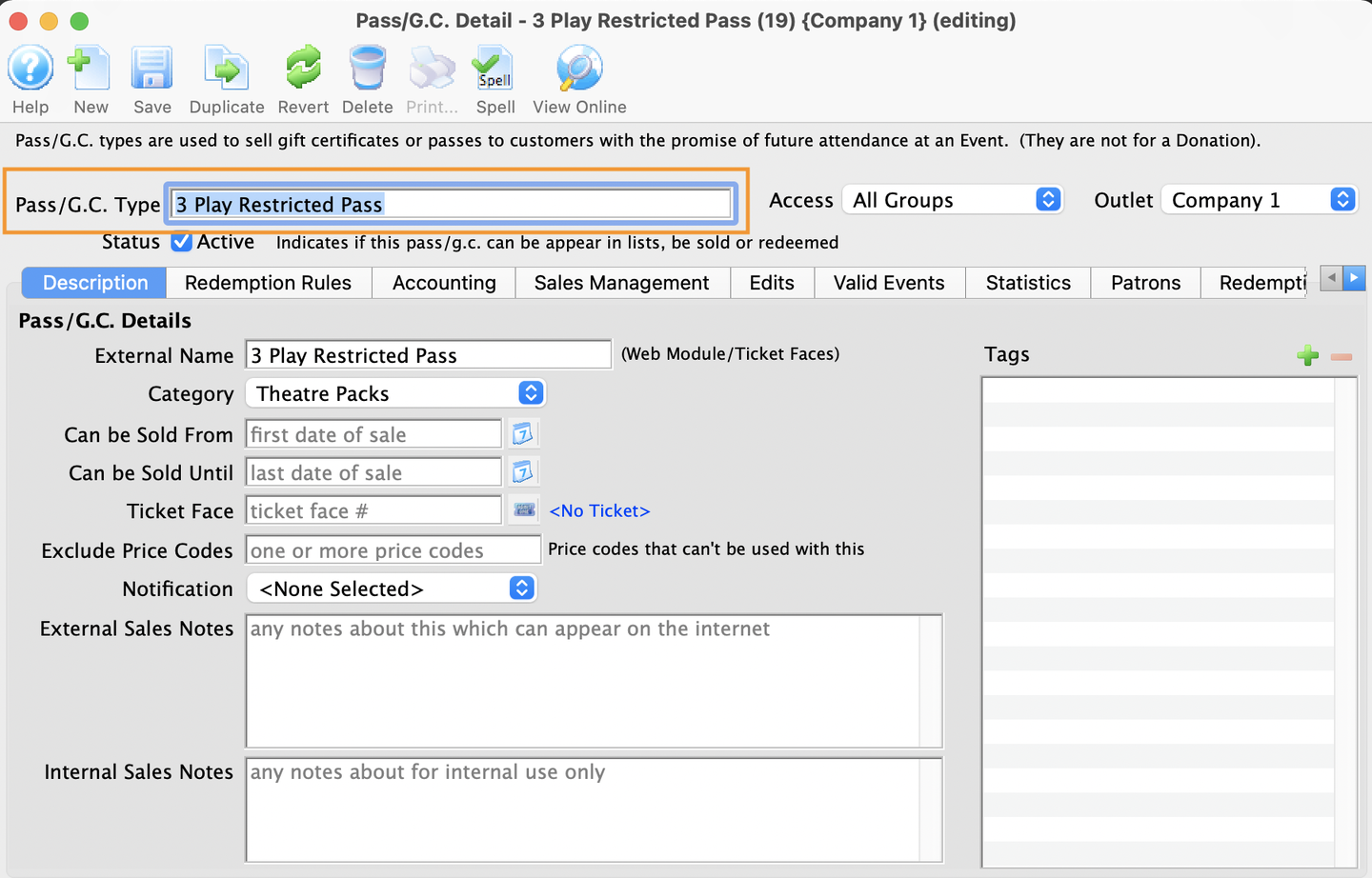
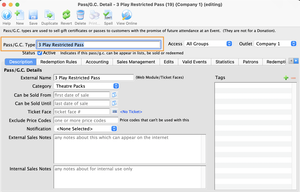
Internal Name used during the creation of the membership, pass, or gift certificate. This field may be different from the external name that patrons will see.
Patrons Top
ADA Top
ADA stands for the Americans with Disabilities Act, but is usually used in its acronym form. Originally a 1990 civil rights law that prohibits discrimination based on disability, the law has been expanded to include specific provisions for the entertainment industry, including regulations about minimums for wheelchair accessible seats, requirements for equal access to accessible seats in online ticketing platforms, fair pricing, availability of sign language interpreters, etc. Here's a 2010 revised ADA regulation summary that highlights key information for arts organizations.
ADA is often used more broadly to refer to a wide array of accessibility needs and goals, regardless of whether they are specified in the law. Some common accessibility topics for theatres include:
- Wheelchair accessible seating
- dedicated seat holds for people who use wheelchairs, service animals, or other mobility supports
- easy independent access locations available in all pricing tiers
- staffing support for people who need or would like an organization's help accessing their seats
- Companion seats
- dedicated seat holds next to (or as near as possible) wheelchair accessible seats for non-disabled people attending with people who use wheelchairs, service animals, or other mobility supports
- Signed performances and seating sections
- dedicated seat holds with a view of both the stage and a sign language interpreter
- section that allows for lighting the interpreter without interfering with the theatrical presentation
- activities to support an interpreter in preparation, such as scripts, rehearsal access, etc.
- Online ticket availability
- wheelchair, signing section or other accessible seating available for online ticket sales with the same system and customer ease as non-accessible seats (often a challenge to make to these available online and also discourage non*disabled people from purchasing them)
- Sensory-friendly performances
- theatrical presentations designed to work for people with autism spectrum, anxiety, sensory processing or other disorders that may make a traditional theatre presentation challenging to attend (loud sudden noises, overly bright lights, expectations to remain seated and still for long periods of time, etc.)
- Hearing devices and support
- easy to use audio support for people with hearing loss, such as headphones and receivers connected to the venue's sound system
- telecoil induction hearing loops that provide wireless and magnetic signals from a venue's sound system to t-coil enabled hearing aids
- closed captioning options for patrons with hearing loss (check out GalaPro)
- General facility accessibility
- box office, scanning, faucet, signage, etc. that works for people with a wide variety of eye-heights
- comfortable restrooms for people who need additional equipment or caretaker support
- dedicated and secure locations for women who need to nurse or use a pump
- Accessible signage
- way finding and other signage that works for people with colorblindness or loss of eyesight
- way finding or other signage that works for people with a wide variety of eye-heights
- emergency exit signage that is obvious and clear to all regardless of their written language of preference
Contact Card Top
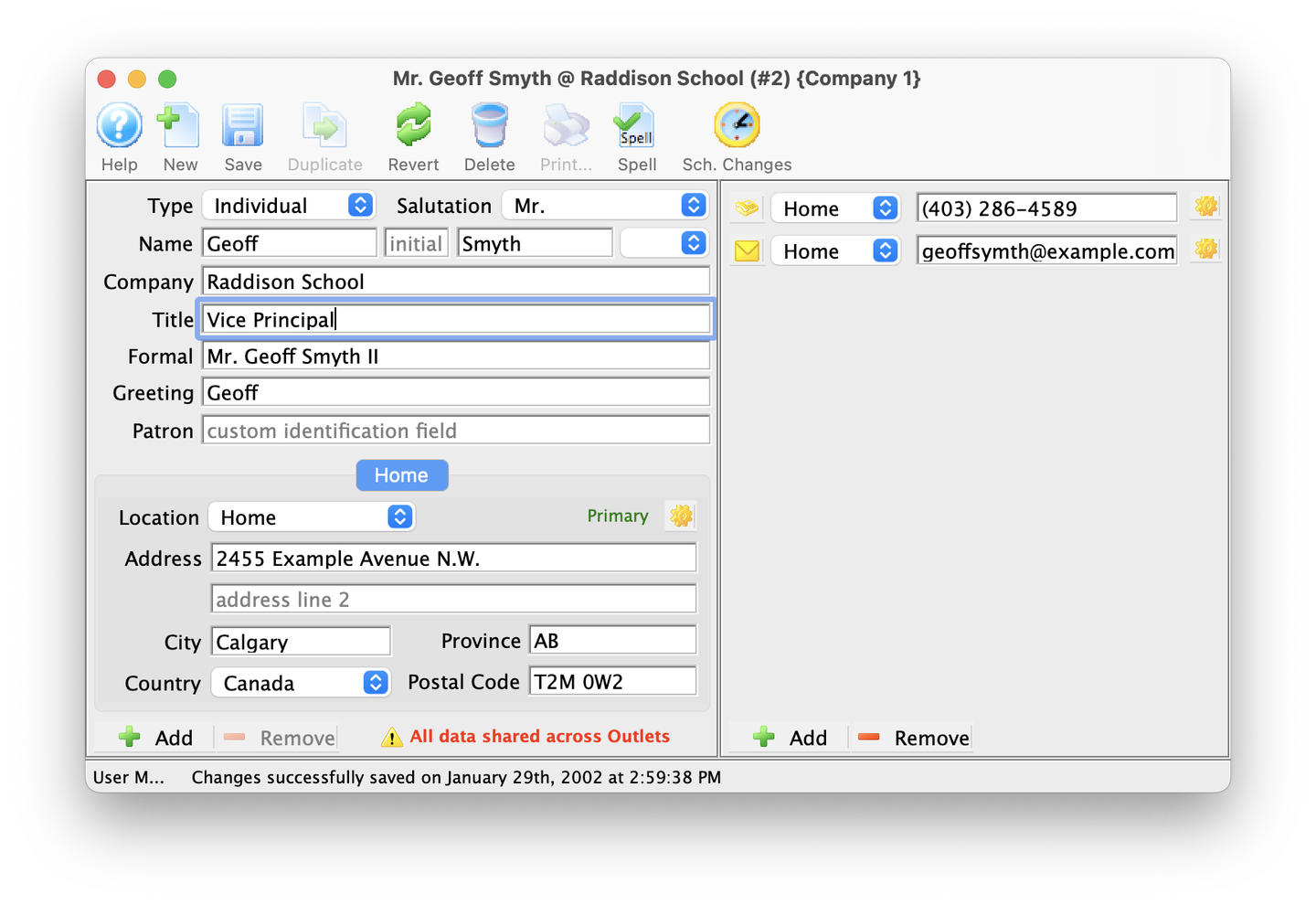
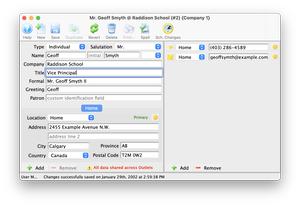
A single location where patron information, contact details and addresses are collected and stored in Theatre Manager.
Contact Information Top
Contact information is data used to directly contact a patron. Contact information is a telephone number, email address, or fax number.
Mandatory Data Top
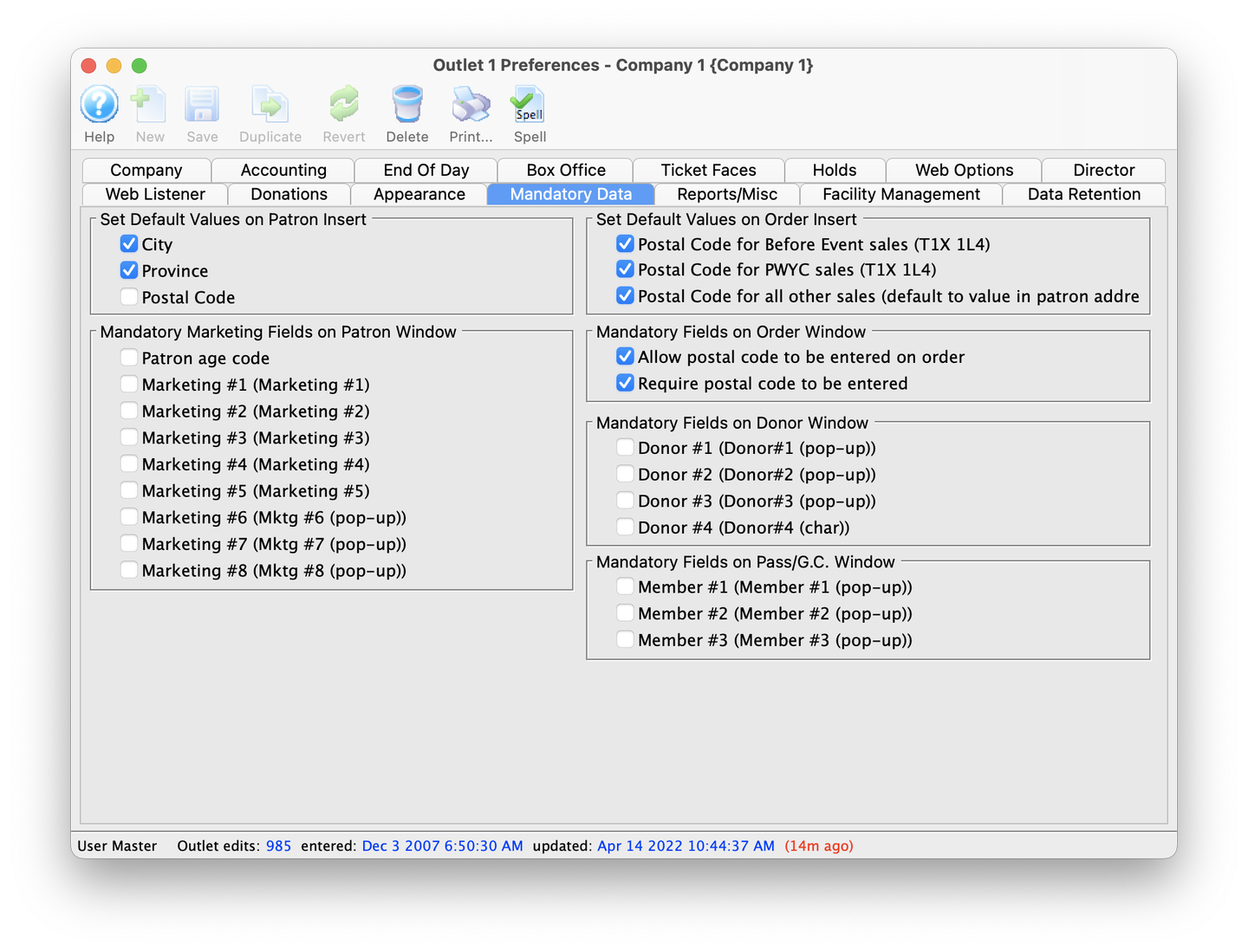
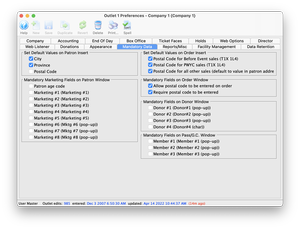
Located in Company Preferences, the Mandatory Data tab allows setting which fields are required when creating a new patron. There are 6 areas an organization can customize:
- Patron Address: City, Province/State, Postal/Zip Code
- Patron Marketing Preferences
- Required Postal/Zip Code for New Orders
- Required Fields on the Order Window
- Patron Donor Information
- Patron Pass/Membership
Patron Top
A person who buys a tickets, donates, is a member, a promoter, a vendor, sponsor or renter. A patron can be any or all of these things. They are a person with whom the organizations has any form of contact.
Patron Management Top
Patron Management is the standards in which an organization processes patron information. This includes data collection and formatting of patron name, company, contact information and addresses.
Patron Number Top
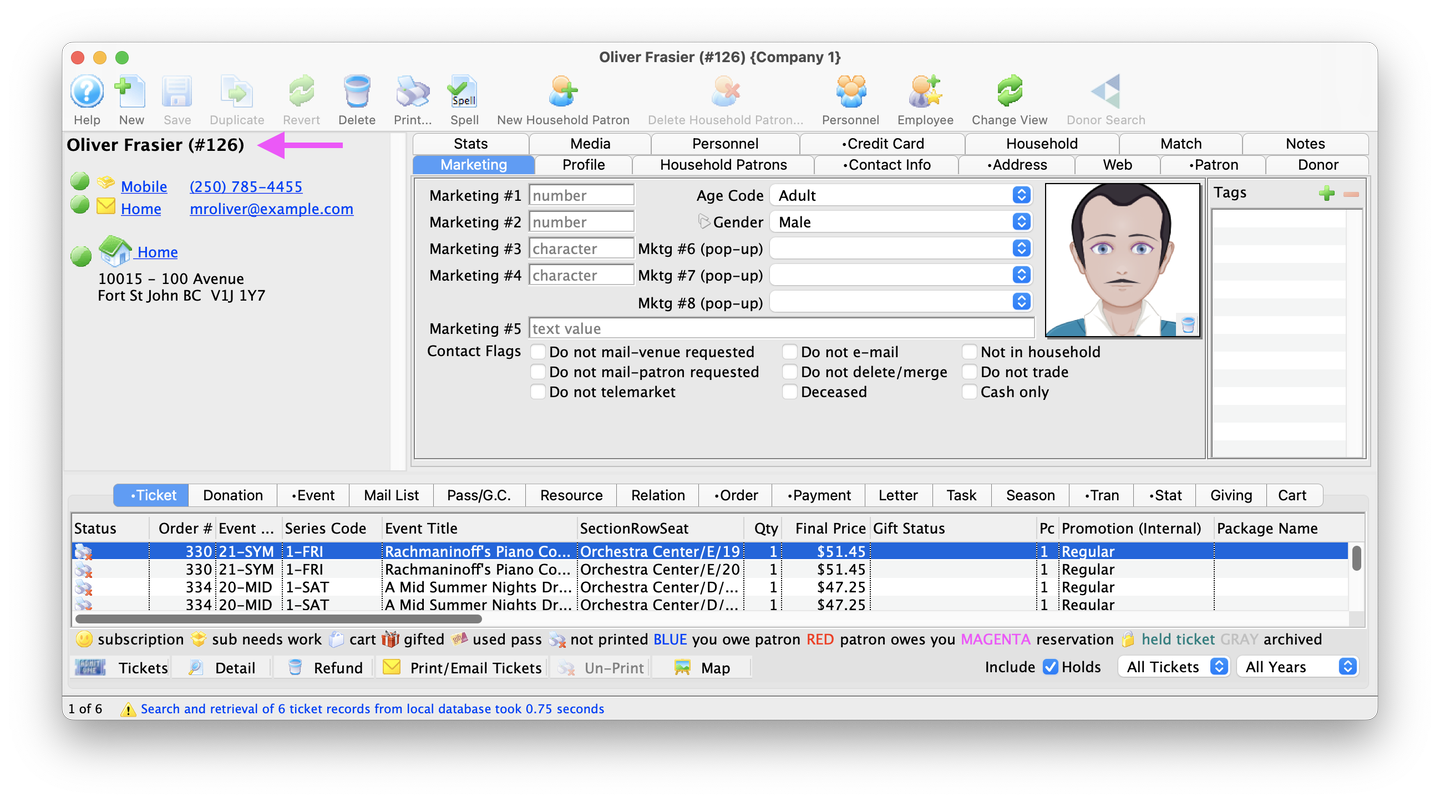
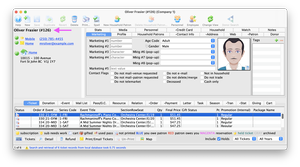
A unique number used to identify a patron in Theatre Manager. When a new patron is added to the database the next available "patron number" is assigned to their patron record. A patron number is never reused, even after a patron is merged or deleted from the database.
These unique numbers are typically referenced in reports and mail lists when working with patron information, and when working to identify duplicate patron records.
Patron Record Top
A reference containing a collection of information for a specific patron. This includes the contact card, purchasing history, correspondence, marketing details, tasks, and much more.
Reporting Top
Reveal Top
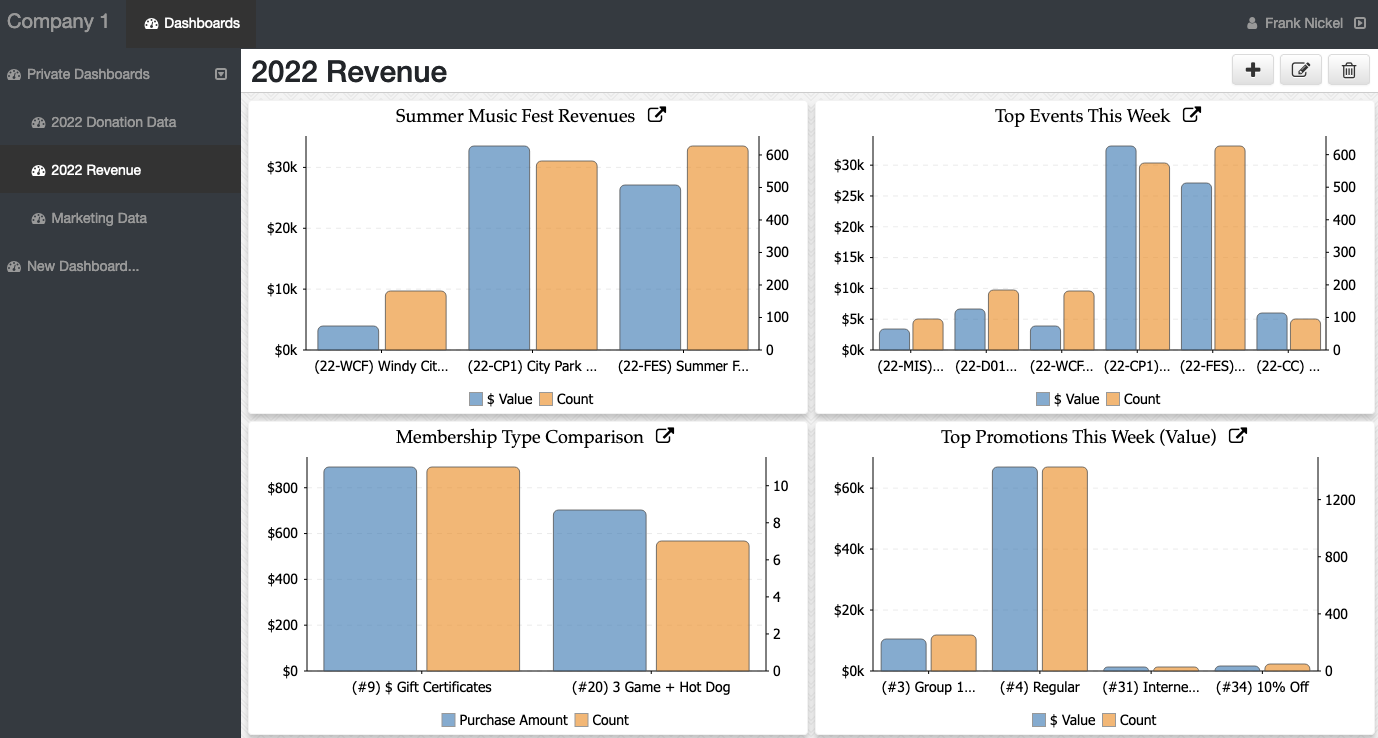
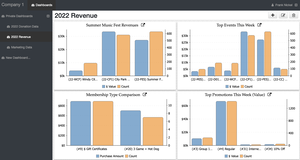
Reveal is the Theatre Manager web application that provides insights into your sales data and operations using graphical dashboard widgets.
Graphs in the Reveal dashboards are LIVE. This means that when you are watching a dashboard, if ticket or donation is taken, it will change the appropriate graph in real time.
Search Criteria Top
Allow users to find specific information in the database. Criteria in Theatre Manager uses a predefined format, allowing users to add and remove pieces of data from their search. Search Criteria is predominantly used for generating reports and mail lists.
Subscriptions Top
Packages Top
Also referred to as a season subscription, is a ticket package which allows patrons to lock in the same seats and performance nights for every show of an upcoming season.
For example, if long time subscribers Betty & Joan Kurt always attend on Thursday evenings, you can sell them a Thursday evening package.
Renewal Period Top
A specific date range where only existing subscribers are allowed to renew their subscription for an upcoming season.
Below is a typical chronology of events for a renewal period:
- Renewal notices are printed and sent
- Renewals are received back from patrons. Regular renewals with no changes are processed immediately. Renewals with changes are processed for payments only, but no changes to the seat assignments are made at this time.
- The Change Request tab in the Favorite Seats file is filled out for reference during change request fulfillment
- New subscriptions may be sold, but as with the above change requests, payments are processed, but seat assignments are not made
- The renewal deadline passes
- Change requests are processed and seated using the Season Subscription-Change Requests report
- New subscriptions that were sold during the renewal period are seated
- New (and very late renewing) subscriptions are sold and immediately processed.
Tickets Top
Comp Top
A comp is a complementary, or free, ticket to a performance. All theatres offer comps for specific people or purposes and need to manage these free tickets carefully in order to balance financial needs with contractual agreements as well as relationship needs. For presenting or renting houses, comps are almost always controlled at least in part by the producer or renter contract. Some common uses of comps are:
- actor/musician/artist VIP guests
- producer VIP guests
- corporate supporter benefits
- donor thank-you benefits
- promotional offers to attract new audiences
- special student or community access
- press seats for show reviewers
- promotional game winners (radio or online offers)
- raffle-won seats from other nonprofit fundraising auctions
Fundraiser Ticket Top
Fundraiser tickets are tickets in that they provide a ticket holder access rights to a specific event and/or performance. They are different from a traditional or regular ticket in that all or some of the paid price is considered a donation, either to the selling organization or to an event-specific charitable cause. Because many fundraising events include additional ways to donate or pay-what-you-will prices or involve some exchange of value that is not tax-deductible, these tickets can be more complicated to set up and/or sell.
General Admission Top
General Admission is a method of selling tickets to an event in which the ticket specifies admittance to a specific performance, but not a specific seat. Customers are granted access to the audience seating area and then pick which seats they watch the performance from. Typically tickets to a general admission event are still good for 1 person per ticket, but occasionally organizations issue group tickets allowing a preset number of people into the venue on only one ticket.
Holds (Seat Holds) Top
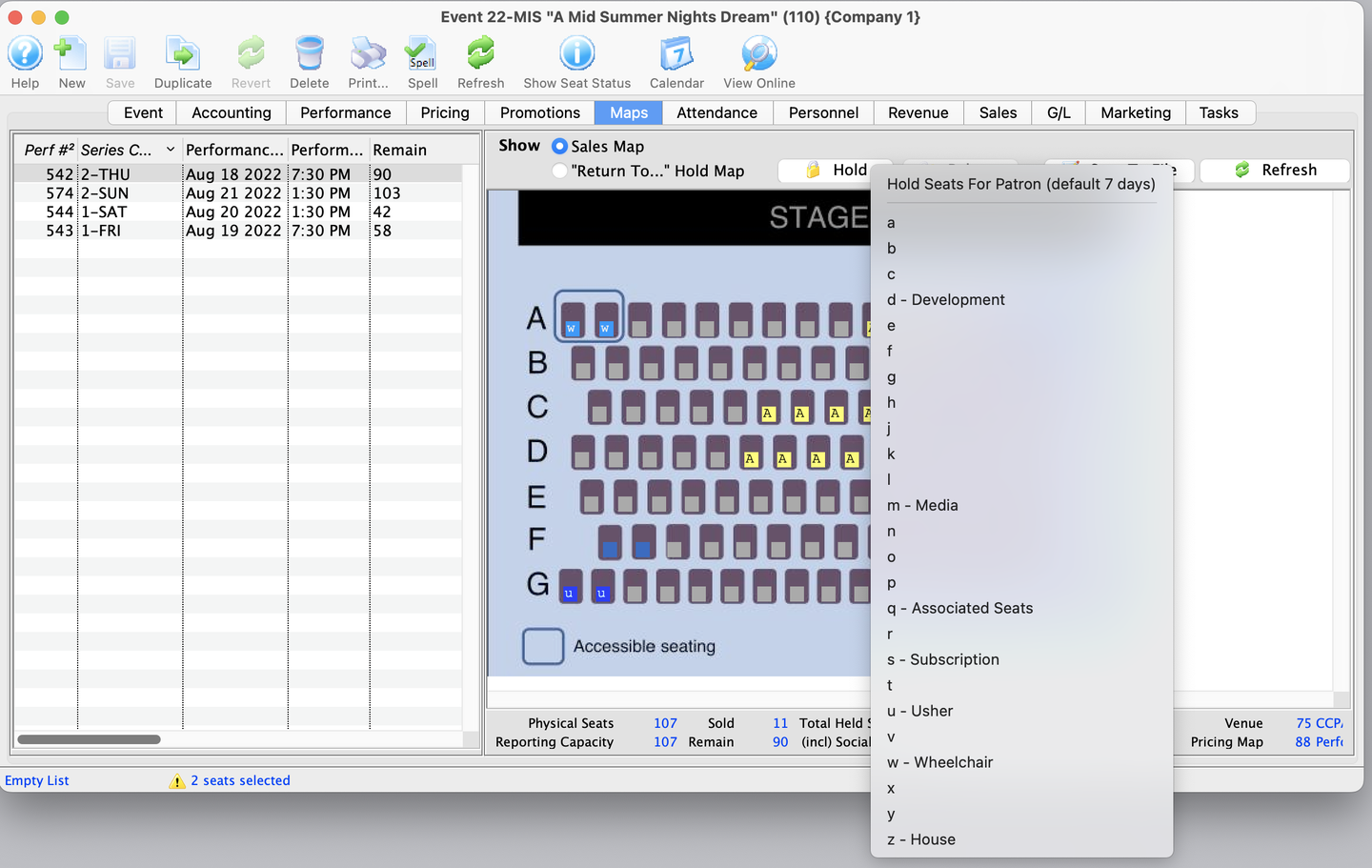
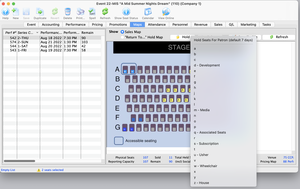
A process in Theatre Manager that "holds" a seat for a specific purpose. Held seats can only be sold by the box office, with staff needing to override the "hold" in order to sell, or, assign to a patron.
Common examples of holds include:
- Development
- Media
- Subscriptions
- Wheelchair & Accessibility
- Ushers
- House & Technical
Holds can be done at the Pricing Map level. For example, usher seats are typically held for every performance.
Or, holds can be set at the Event level. For example, media comps are typically held for previews and opening nights, but not throughout the run.
Linear Barcode Top


A barcode is a method of representing data in a visual, machine-readable format. Now commonly referred to as linear barcodes, these can be scanned by special optical scanners, called barcode readers, that use a narrow beam of light to scan the item. Many traditional (non-electronic) theatrical tickets use linear barcodes with scanners to quickly admit audiences to a specific performance.
Reserved Seating Top
Reserved Seating is a method of selling tickets to an event in which the ticket specifies admittance to a specific performance AND a specific seat. Customers are obliged to watch the performance from the preselected seat location indicated on the ticket. Because the seating location is predefined, tickets to reserved seating events are only ever good for 1 person per ticket. Most of the time, customers agree to the specific seat location at the time the ticket is issued, though in occasional circumstances the organization will select the seats for a customer.
Ticket Top
A document issued from an organization to a customer that entitles that customer access an event. Typically, theatrical tickets are good for a single seat at a specific performance time. For example, an event may have four performances (Friday at 8PM, Saturday at 2PM, Saturday at 8PM, Sunday at 2PM), and a ticket is good for one admission only to Saturday at 8PM.
Historically, a ticket was issued via a physical document. Anyone in possession of the document had the right to attend the specified performance. The physical document was critical for admittance and had to be returned to the organization for a refund, exchange or transfer to another person. Today, many organizations issue electronic tickets with a bar code or QR code and, when an issue around document ownership arises, the organization honors only the customer attached in the issuing system to the ticket. Increasingly, organizations are treating tickets as licenses that they can revoke at any time, regardless of who holds printed copies of the document.
To note, theatrical organizations often distinguish between tickets and registrations, which usually refer to access rights to multi-day festivals, camps or special fundraising events like dinner galas.
Ticket Number Top
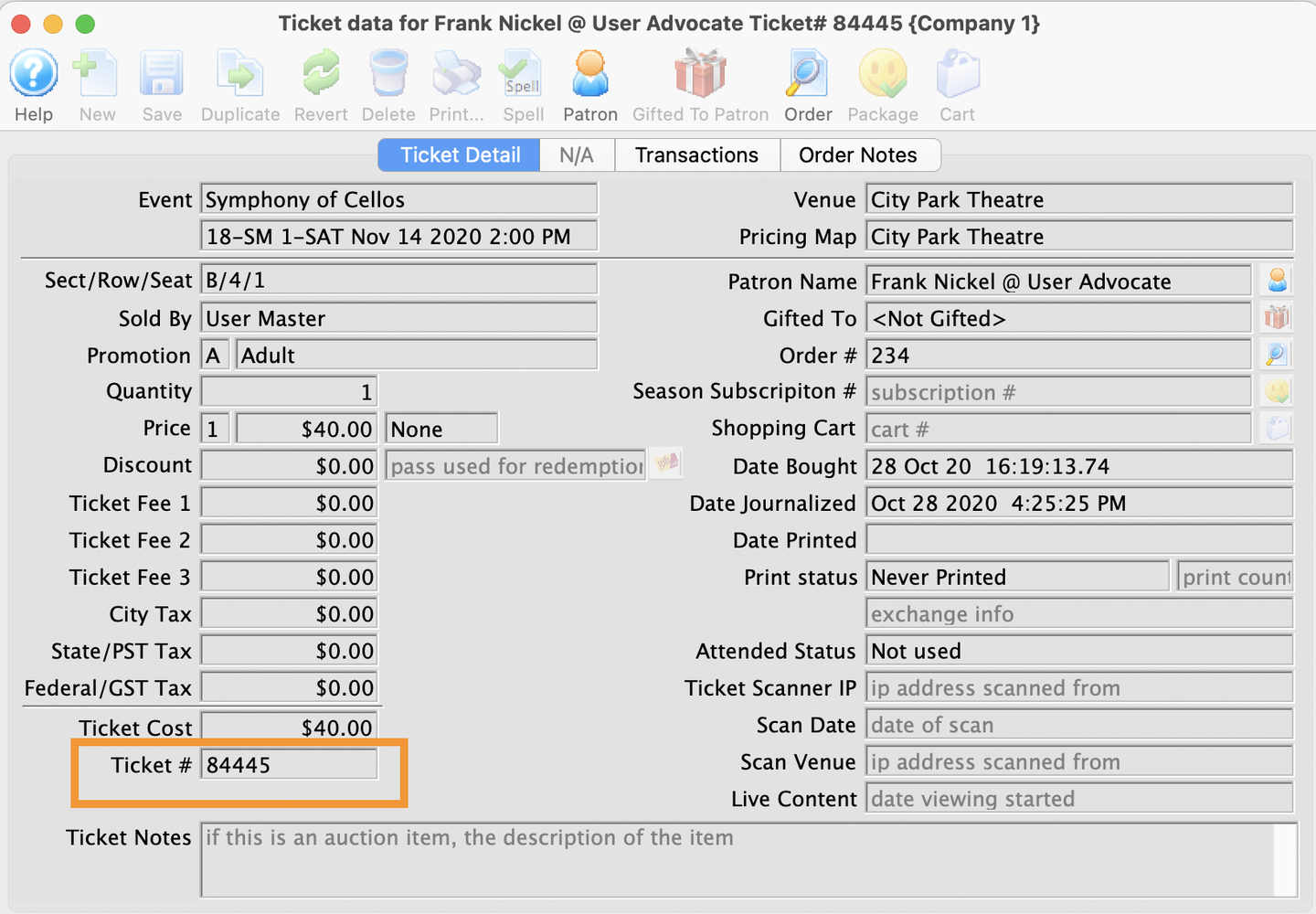
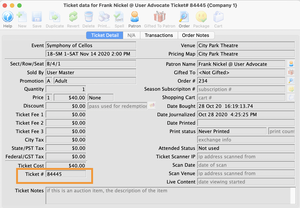
The Ticket Number is generated by Theatre Manager and can be used for tracking purposes. Most commonly the ticket number is either scanned or typed into Theatre Manager to track attendance.
A ticket number cannot be changed within the database. They are sequential and thus cannot be reused or reset to start from a previously used number. Each number is assigned sequentially based on the last ticket number issued in the database, whether it be a Festival Seating (General Admission) or Reserved Seating performance.
When a Reserved Seating performance is created, each seat within the map is assigned a ticket number. The number belongs to a single seat within the performance for the event. When the ticket is sold this number prints on the ticket face and is used to create the QR or bar code. When a ticket is refunded or exchanged, that ticket number continues to belong to the seat and that same ticket number will continue to be used even if that ticket is re-sold to another patron.
Traveling Troupe Top
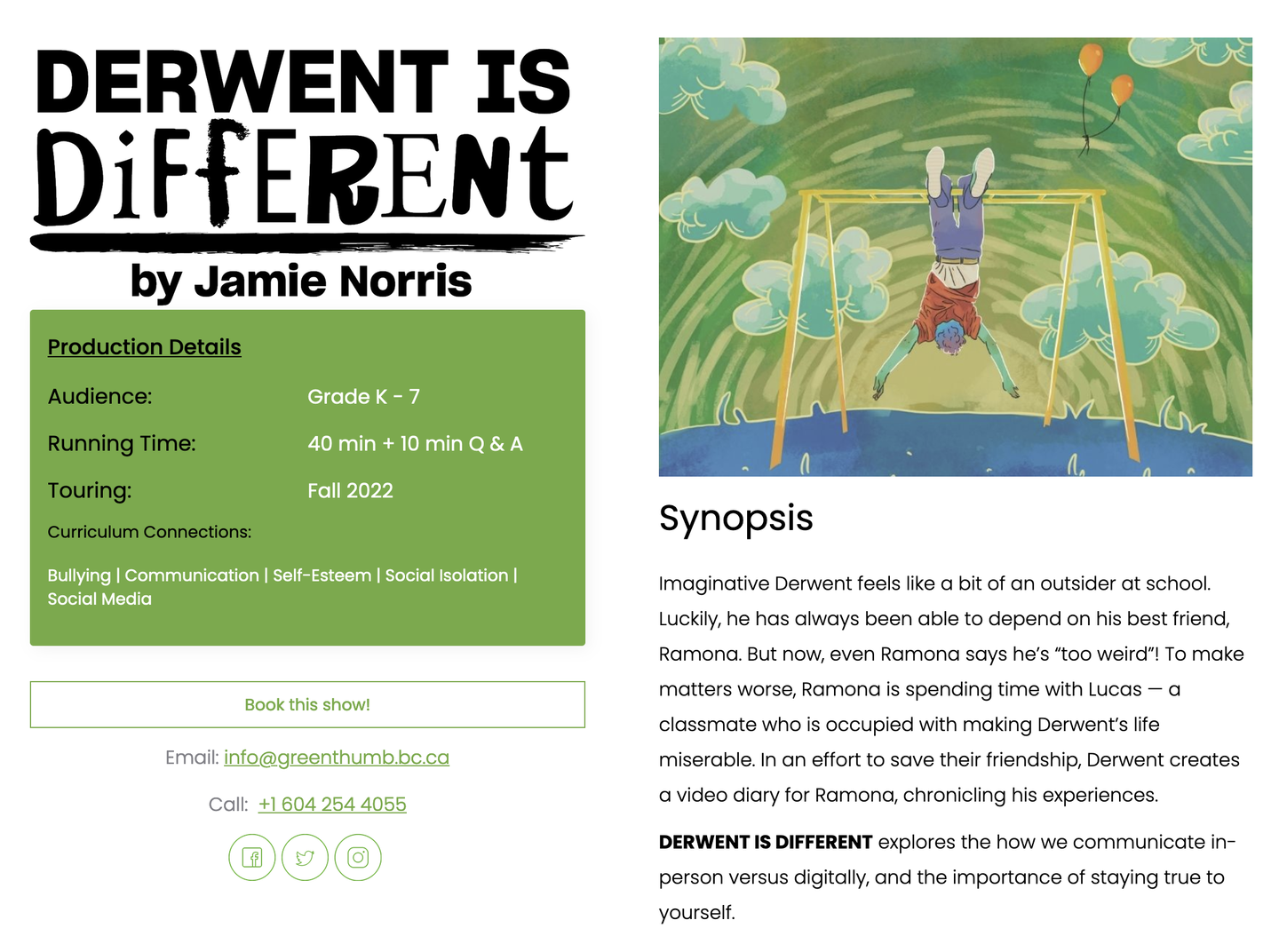
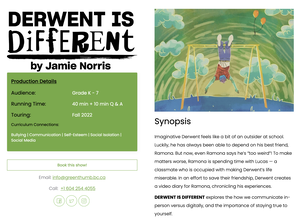
Traveling Troupe, also known as Tour Booking, is a type of event created in Theatre Manager to support production companies that tour. Designed as a method to record each road performance, including the income from the booking, touring information, and demographic data about the audience.
Because Traveling Troupe events and performances only sell 1 "ticket" to the booking contact person, the usual Venue and Pricing Map information for the event are not required.
QR Code Top
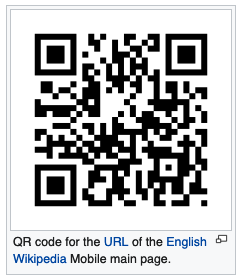

A QR code (Quick Response code) is a type of matrix barcode (or two-dimensional barcode) that consists of black squares arranged in a square grid on a white background, which can be read by an imaging device such as the camera on a smartphone.
Unlike the older, one-dimensional linear barcodes that were designed to be mechanically scanned by a narrow beam of light, QR Codes scan much faster and are more reliable.
Today, most smartphones have built-in QR code readers that allow organizations to provide a fast and easy way for customers to navigate to additional online content from a printed poster, program or sign. Many electronically distributed theatrical tickets are use QR codes to quickly admit audiences for a specific performance.
Venues & Maps Top
Graphic Map Top
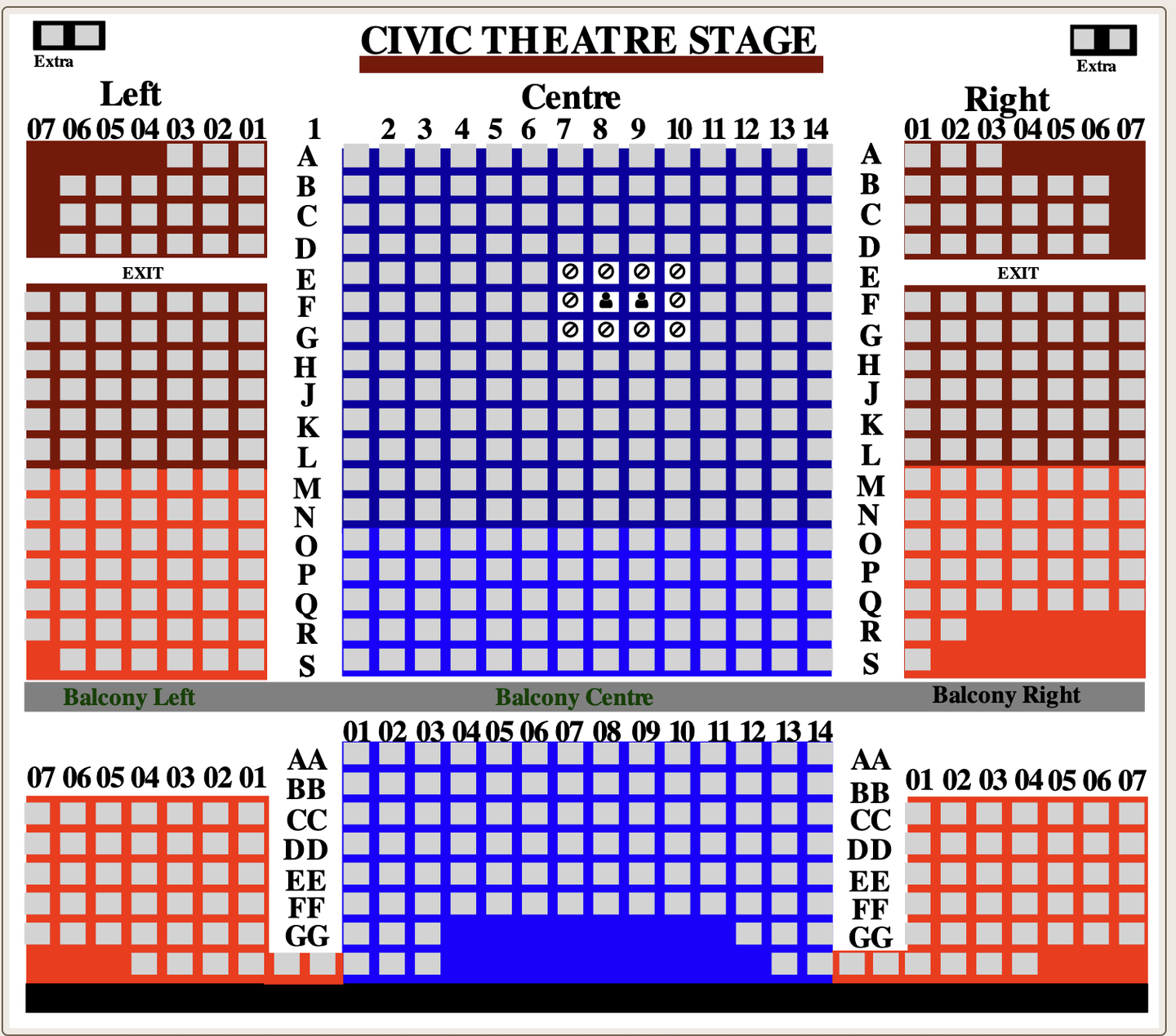
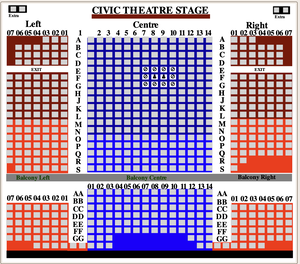
A graphic map for a venue theatre is a visual representation of the layout of the theater, including the stage, seating areas, and any other relevant areas such as lobbies or backstage areas via the box office or internet.
Place Seats SVG map Wizard Top


The online select-your-seat process has predefined computer code associated with each seat, and it must be merged in to allow the patron to interact with the selection process. This code cannot be changed by the user, but it must be merged into a basic SVG map in order to work.
After preparing the SVG map per the previous instructions, you will need to use this wizard to merge the map with the rest of the programming code that will actually make it work. Fortunately, this is automated and is a quick process.
Pricing Map Top
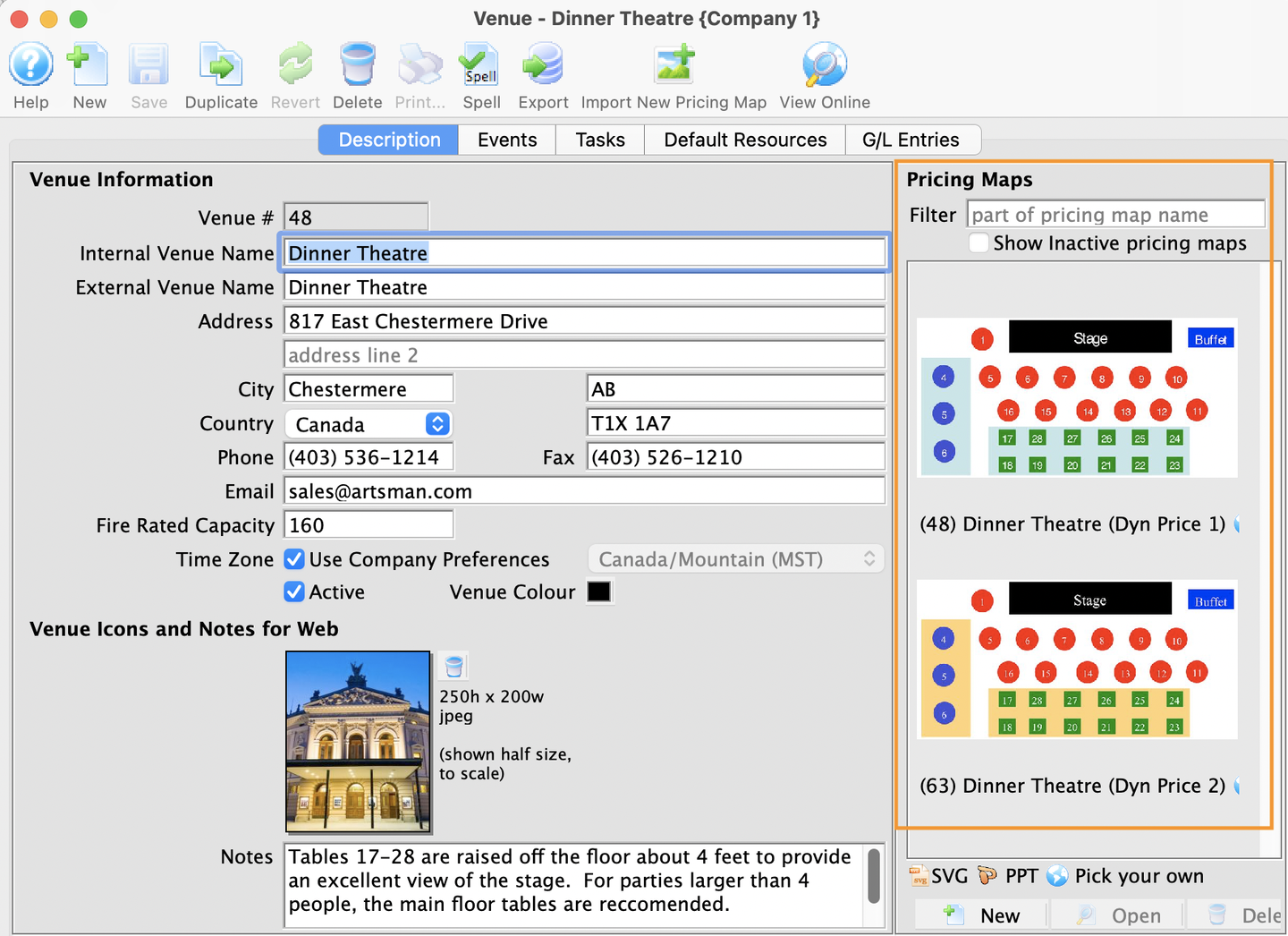
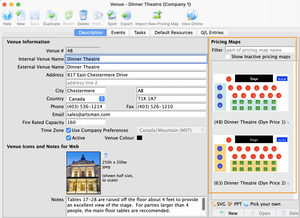
A Pricing Map in Theatre Manager is used to combine physical seats with a pricing structure.
For example,
- If the venue is a theatre, the seating is fixed, but a Pricing Map allows organizations to have different pricing layouts. For event A, all seats could sell for the same price of $35. For event B, the seats break down into different zones, with seating in the Center Orchestra costing $65, the Side Orchestra costing $55, and the Balcony costing $48.
- If the venue is a Dinner Theatre, the seating may change from event to event. The overall capacity of the room stays the same, but the configuration of seats changes each time the venue is used. Each new configuration is the same Venue, but is a new Pricing Map.
- For conference room or classroom venues, it may suffice just to have a Festival Seating (or "General Admission") Pricing Map, or you can have a Festival Seating Pricing Map for some events, and a Reserved Seating Pricing Map for other events.
Seat Names Table Top
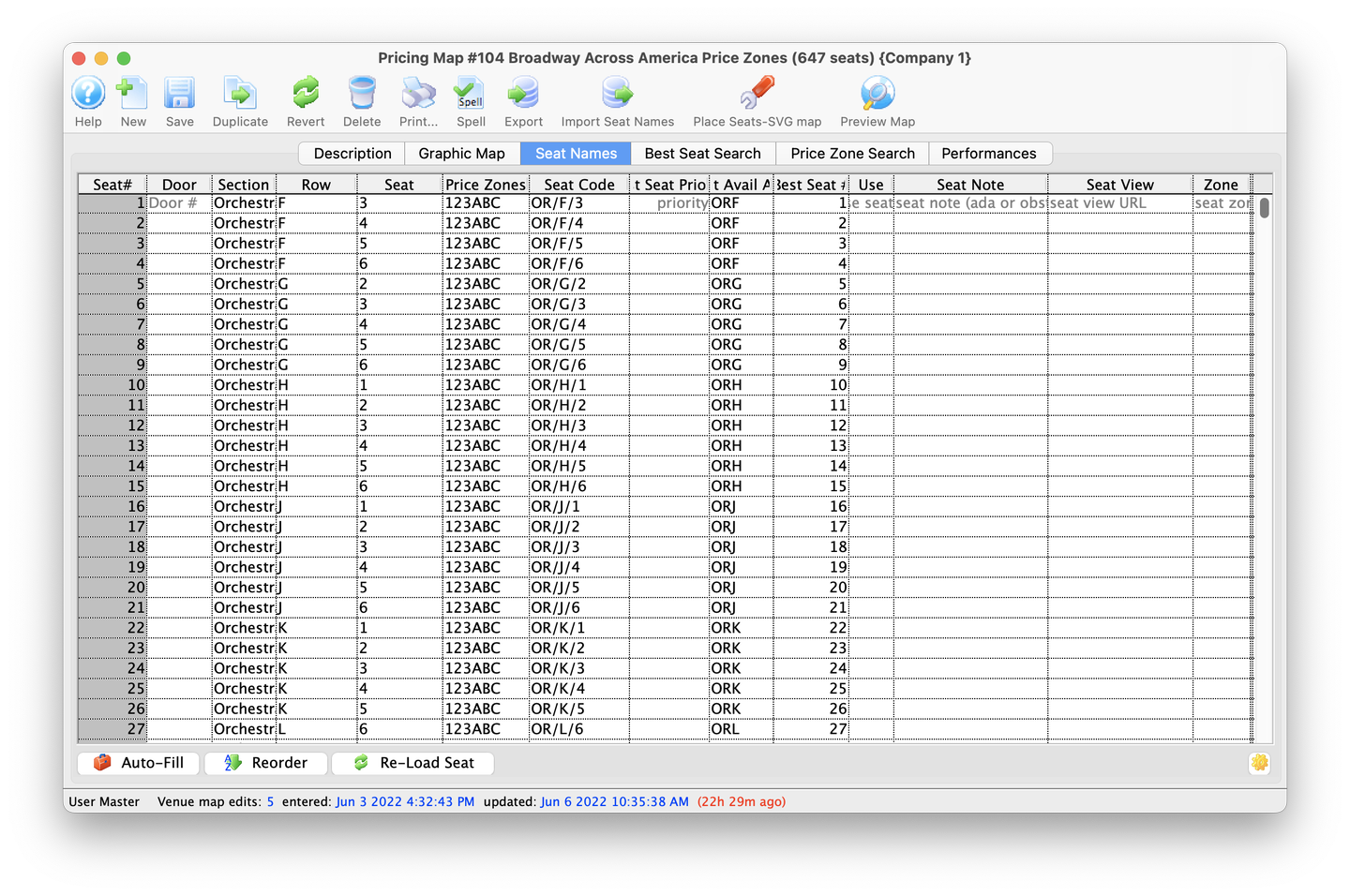
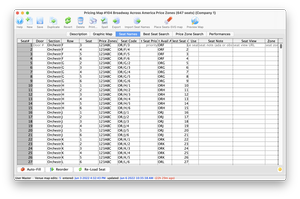
The Seat Names Table determines the name of each seat within the venue and how it can be sold. Every seat must be given a physical location that the patrons understand.
Theatre Manager provides a four level naming convention of door, section, row and seat (entrance door is optional). Each of these fields is alphanumeric, so directions to the seat can be provided that represent the venues current naming conventions.
Examples:
* **Theatre:** Orchestra - Row A - Seat 101
* **Arena:** Door 9 - Section 16 - Row F - Seat 44
* **Dinner Theatre:** Table - 8Social Distancing Top
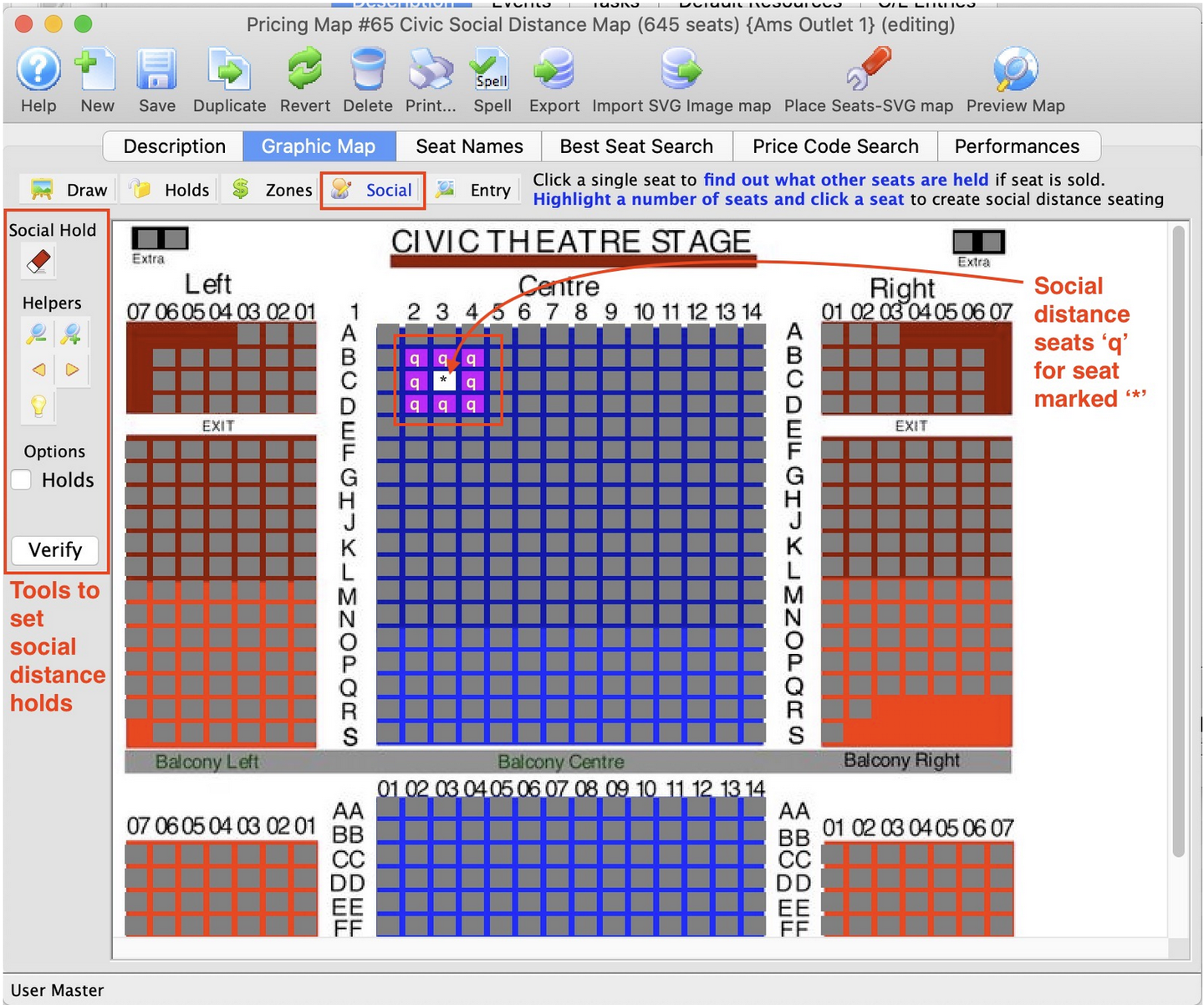
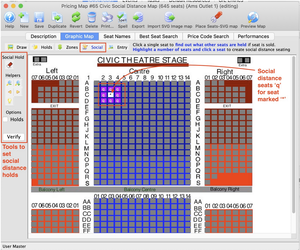
The name of this feature is called social distance seating. It is a by-product of Covid19 and the resultant need to sell a seat and automatically hold other seats around that seat so that people are provided a comfortable social distance between parties.
Theatre Manager has provided this feature for years (formerly called associated seats) and it can be used for a variety of purposes such as:
- Automatic holds for ADA companion seats
- Seats in a dinner theatre for two-top's to avoid a patron sitting for dinner with a stranger
- sitting opposite.
- Similarly, Social Distance seats are held automatically when a groups are bought to maintain an
- appropriate distance between patrons in all directions.
Venue Top
The words "Theatre" and "Venue" are generally synonymous with each other. The places where you perform may be called a Theatre, Concert Hall, Arena or some other term. In Theatre Manager, we refer to all of these as the generic "Venue." It's a distinct individual space where events or meetings take place. A venue can take on a variety of different physical setups, so it may contain multiple maps or seating arrangements.
In the theatre industry at large, venue refers specifically to the theatrical performances spaces. For example, an organization may own a building with offices on the second floor, a small movie theatre, a traditional proscenium stage and audience, and a lobby with a box office and cafe. When employees talk to show producers or presenters, they will say they have two venues, each of which will have a detailed tech pack outlining the important size and system specifications relevant for mounting a theatrical production.
Venue is often used as a synecdoche (isn't linguistics awesome?), referring to the presenting or renting organization as a whole that runs one or more theatrical spaces. In this context, it is used to differentiate a presenting or renting organization from the organization that produces the show or rents the space.